#not an analysis but still a long post written by me therefore it belongs in that tag.
Explore tagged Tumblr posts
Text
wait okay. instead of going to sleep like a normal person. here's how I'd change the ages in bsd (for those that have a canon age), bc no one looks their age/it makes the timeline feel weird, i wanna let at least some major past events breathe a little between one another. possibly controversial takes ahead:
atsushi: i like that he's 18 actually. he looks and feels 16 but no yeah 18 works better. I'd say 20-21 would be nice but that'd reallyyyy throw his backstory's timing off unfortunately
dazai: 25
kunikida: around 27-28
ranpo: 28 also, maybe even 29 (his whole thing is that he looks young for his age anyway)
yosano: 28 as well
tanizaki: like. he does look 18. but also 16 and 21 at the same time. i like him as a bit older than atsushi so let's say 19-20, and naomi as well while we're at it
kenji: why is he 14. it's not that he doesn't look 14 it's that i simply did not expect a child to be the muscle in a detective agency. so please make him like at least 16 which is only just slightly better tbh
kyouka: yeah 14 is chill in her case imo. makes her more tragic 👍
katai: 27-29ish as well
fukuzawa: at least in his 50s. maybe 55ish, or even more. he def looks like it and it fits more with having a son in his 20s
akutagawa: i do want him to be older. but making his age gap with atsushi bigger is weird. so keeping him as a 20 y/o it is, maybe 21 at most
chuuya: 25
kouyou: 30s. early 40s even. she is already so milf coded. finding out she's 26 in canon was straight up offensive i swear. come on.
higuchi: 21
tachihara: 22 or 23 maybe? (the hunting dogs don't have canon ages but i like jouno and tecchou as 26ish so that way he's still like the baby of the group)
hirotsu: how is that man 50. make him 65 at least. jfc. the whole point is he's been with the mafia a long time. ik they keep recruiting teenagers for some reason but give me a break. my dad is pushing 70 and looks younger than him
q: actually my issue with them isn't that they don't look their age (tho they do look a bit younger ig) but that timeline wise?? they're so weird?? why did the mafia have a 6 y/o on deck that's just inconvenient for all parties involved. like i can excuse kyouka at 11ish but come ON. at least make them 10 in fifteen. or just bring them in later bc i just realized the timeline doesn't line up with the dazai and chuuya changes otherwise. man idk
odasaku: girl that man was NOT 23 when he died he should've been like at least 27 then
mori: late 40s or early 50s. keep the few years gap from fukuzawa maybe but he should still be older
ango: 29ish in the current timeline. or even 32. idk why but that number feels right.
francis: 45 at least. how is a 32 y/o man supposed to have a daughter old enough to study abroad...
poe: 29
melville: actually he is the only one aged correctly in this entire manga. bestie 🔥🔥🔥🔥
steinbeck: 24. maybe even older
lucy: 20-21ish. same issue as akutagawa really
louisa: 25 at least please 🙏
nathaniel: 34 maybe.
margaret: also early 30s. how the fuck is she 20. like kouyou this is straight up insulting 😭
mark: ageless for he is the spirit of youth and joy (yeah 22 is chill for him actually. he's like the taylor swift song. he'd love that)
mushitaro: tbh I'd make him more around 29 or even older than 30. like he would be a believable 35 y/o to me if needed.
nikolai: actually him being 26 is chill too. tho i wouldn't mind making him around 28-29ish too since i already aged up most 26 y/os so may as well go all the way.
shibusawa: yeah he can stay 29 too idm. i actually didn't know he had a canon age until now. cool!
i think that's everyone who has a canon age (excluding lns bc i haven't gotten to them yet)? aside from sigma maybe but his age is more of a plot device than a fun fact. and fukuchi is implied to be the same age as fukuzawa so, yeah just make them the same in this case too.
i did mess up the timeline myself with this. so lemme clear it up:
The War and the whole thing with mori and yosano still happened when she was 11, so 17 years before canon. that means mori was still in his 20s back then, no big change
untold origins still happened when ranpo was in his teens, honestly we can keep it 14, so 14 years ago, meaning fukuzawa was in his late 30 or early 40s. again not too big of a change I'd say
fifteen happens when. well. dazai and chuuya are 15. ten years ago. i don't want q there get them out of my sight (for now) let them be a kid for a bit!!!!! but yeah like in canon that means the previous boss's murder was a year before, 11 years ago. also while we're at it, stormbringer is also the same aka a year after 15
now this is where we shake things up just a bit. rather than occuring when dazai is 18, i think we can push the dark era to when he's 20 and still maintain the whole childlike thing he has going on there, it's not that big of a difference imo.
that means, 5 years before canon instead of 4, making akutagawa 15 back then, and ango 27 like odasaku.
also yeah q comes in at some point in the middle between those^ I'd say close to dark era than fifteen.
originally i wanted to make skk 26 but this started stretching things even more. bc now we gotta figure out how long dazai spent in hiding. and ig we can keep it 2 years and just make it so his entrance exam was 3 years before canon. again imo not that big of a stretch 🤔
idk why i said this changes the timeline a lot i think this is p simple. also lets ppl stew in their situation for just a bit longer which i like more.
thank you for reading. you are very brave and strong for pulling through. feel free to disagree with my takes but just be nice about it please. I'm also open to hearing other takes if you have any that i didn't consider 🫡 but again just be nice okay?? 🥹
#long post#no read more button. dance#okay NOW i should go to sleep lol I've been typing this for like an hour 😐#dan rambles#not an analysis but still a long post written by me therefore it belongs in that tag.
35 notes
·
View notes
Note
I was wondering if you could recommend me some books about otma? I want to learn more about their hobbies and what they liked etc, I saw some of your posts and you had lots of good information so I thought I might ask
Hello! Thank you for your question. Here are some of the best books about OTMA
Firstly, secondary sources (written in modern times by historians and/or experts)
Romanov Autumn: The Last Century of Imperial Russia by Charlotte Zeepvat is my favourite secondary source on the Romanovs. It has chapters on many different family members, so might not be ideal if you want to learn just about OTMA, but I think it's a great introduction to the topic.
Nicholas II: The Imperial Family by Olga Barkovets and Valentina Tenikhina is a coffee table book, but has lots of photographs of the Romanov's and their belongings and focusses heavily on the life of the Romanovs, rather than politics. There are a few errors in it, but nothing totally egregious. I picked up a copy from a second hand bookstore for $0.99, and it's one of my favourites.
‘After that we wrote.’: A Reconsideration of the Lives of Olga, Tatiana, Maria, and Anastasia Nikolaevna Romanova, 1895-1918 by Althea Thompson is a dissertation/thesis so is more 'academia' focussed than the other books. It's a long read, but very interesting analysis of OTMA's daily lives and their roles.
Primary sources (documents, diaries, letters, etc, from the time)
The girls' diaries and letters have been translated by Helen Azar and various other collaborators under the following titles:
The Diary of Olga Romanov: Royal Witness to the Russian Revolution
Tatiana Romanov, Daughter of the Last Tsar: Diaries and Letters, 1913–1918
Maria Romanov: Third Daughter of the Last Tsar, Diaries and Letters, 1908–1918
Anastasia Romanov: The Tsar's Youngest Daughter Speaks Through Her Writings
Similarly, Correspondence of the Russian Grand Duchesses: Letters of the Daughters of the Last Tsar by George Hawkins has hundreds of letters that OTMA sent and received. Letters generally show more of their personalities and interests than their diaries, which were mostly a written log of daily activities (but still very interesting and have lovely anecdotes).
Six Years at the Russian Court by Margaretta Eagar was published in 1906, after Eagar left her position as nanny. Therefore, it only has information about when the girls were children, but it is certainly a gem. Lots of information about daily routines and OTMA's personalities. Eagar also wrote several articles for magazines, which have more information and were popular, but they are difficult to track down. Some extracts have been reproduced in From Cradle to Crown: British Nannies and Governesses at the World's Royal Courts. I have two of the articles in my collection and will try and scan and share them soon.
Thirteen Years at the Russian Court: the Last Years of the Romanov Tsar and His Family by an Eyewitness by Pierre Gilliard is, in my view, a must read. Gilliard was tutor from 1905 to 1918, and accompanied the Romanovs to Ekaterinburg before being separated. Lots of information about OTMA's education, their personalities and appearances. A wonderful little book.
Margaretta Eagar and Pierre Gilliard's books were written over a century ago, meaning that they are in the public domain. Therefore, they should be very easy to find free to read online.
Personally I would avoid the two of the more famous/popular books: The Romanovs by Montefiore and Four Sisters by Rappaport. Both have glaring errors and biases. Montefiore's in particular has no references attached to the physical book, so it's difficult to verify the questionable information he shares.
You can find more information about book recommendations here, here, and here. Furthermore, anything that I tag #sources on my blog contain information about OTMA, such as diaries, letters, memoirs, or any other interesting historical info, and are usually referenced. Happy reading!
9 notes
·
View notes
Text
This is probably not the best place to ask, but you’re also a Christian woman too. I was wondering what you thought about what the Bible says about women and how we must submit to husbands and some other stuff that has me (a potential ace) Christain woman kind of terrified. I would go to my church but social anxiety and my church is pretty conservative. I don’t want to think that we’re just second rate citizens with this. Um…that’s all. You don’t have to answer. Love your Tumblr. It’s one of the main ones I look at. Thanks for countless enjoyment!
— — —
(I’m responding on the submission and not the ask because the ask refused to post properly, I think it was too long for Tumblr’s fancy)
So I know you just asked for my thoughts and not a biblical interpretation lesson, but I didn’t spend 3 months writing an exegesis in college for me to never use those skills again, so buckle up for something of a long answer! (literally, this is almost 3 thousand words, so....sorry about that) *rubs hands together* The thing we need to take into consideration when reading the bible is Interpretation; any truly honest biblical scholar would tell you it is a mistake to take every word in the bible at its literal face value, ESPECIALLY since most of us are reading translations of scripture, not the original ancient hebrew/greek/aramaic/whatever else. So when interpreting scripture, we must consider these things:
Author (Who wrote it?)
Audience (Who was it written for?)
Context (What is written around it?)
So the verses you’re referencing are Ephesians 5:22-23, and in the NIV, they read as follows:
22 Wives, submit yourselves to your own husbands as you do to the Lord. 23 For the husband is the head of the wife as Christ is the head of the church, his body, of which he is the Savior. 24 Now as the church submits to Christ, so also wives should submit to their husbands in everything.
Isolated from author, audience, and context, they sound pretty sexist, don’t they? And male authority figures have used these verses as justification for the oppression of women for centuries, just as white men used the passage only a few verses away, Ephesians 6:5, as justification for the oppression and ownership of black people (Slaves, obey your earthly masters with respect and fear, and with sincerity of heart, just as you would obey Christ). So let’s look at each of the points above in regards to Ephesians 5 and 6. First, who wrote it? Sometimes that can be a tricky question to answer, but in this case, it’s actually very easy (though there is still a bit of fuzziness/debate). Traditionally, Ephesians is one of the Apostle Paul’s letters to the early church. Specifically, to the body of believers in Ephesus, a Greek city that was a part of the Roman Empire at the time. According to two different study bibles I have, the letter of Ephesians was not addressing any particular problem that the church in Ephesus had (as was often the case with Paul’s letters), but was meant as an encouragement of faith and to increase his readers’ understanding of what it meant to be a follower of Christ. So now what about the Context? Why are the verses at the end of chapter 5 and beginning of chapter 6 so damning to our modern sensibilities? To answer that, we must look at the passages both in context to the verses around them, and in historical and cultural context (which is where 1 & 2 come into play again). Going back to the beginning of chapter 4, which is subtitled “Unity in the Body of Christ” (and remember, these subtitles and groupings were come up with LONG after they were written; we grouped sections together in a way we thought was most logical, which honestly for a book as short as Ephesians I would argue is barely even necessary), we can see that the letter from chapter 4 onward is about living a Holy and Godly life. Chapter 4 urges us to be “completely humble and gentle, be patient, bearing with one another in love” and warns us against living “as the Gentiles* do, in the futility of their thinking.” *Gentiles in this case meaning not neccesarily all non-Jews, but non-believers. AKA, we should live like Jesus lived, WWJD and all that jazz. If the Holy Spirit is in our hearts and our relationship with God is at the forefront of our lives, then that should show clearly in our actions. The very first verse of chapter 5 reads “Be imitators of God, therefore, as dearly loved children and live a life of love, just as Christ loved us and gave himself up for us as a fragrant offering and sacrifice to God.” Chapters 5 and 6 especially are meant to act as a sort of guide for how a follower of Christ should act. There’s some stuff about obscenity, greed, sexual impurity, 5:15 sums it up pretty well basically, “Be very careful, then, how you live- not as unwise but as wise,” and then we reach the all important verse. Ephesians 5:21, “Submit to one another out of reverence for Christ.” That’s a full sentence, just that there. Submit to one another. The following three sections are all subsections of this point: one for Wives submitting to Husbands, one for Children submitting to Parents, and one for Slaves submitting to Masters. But when looking at all of these, bad shepherds (ie, racist, sexist assholes) like to ignore that first bit, submit to one another, just as they like to ignore 5:28, which says “husbands ought to love their wives as their own bodies. He who loves his wife loves himself;” or they ignore 6:4 which says “Fathers, do not exasperate your children; instead, bring them up in the training and instruction of the Lord;” and they ignore 6:9, “Masters, treat your slaves in the same way. Do not threaten them, since you know that he who is both their Master and yours is in heaven, and there is no favoritism with him.” I do highly encourage you to read chapters 4, 5, and 6 in full, or at least start at 4:17, which is where Paul starts talking about “Living as Children of Light,” because it makes the intent of these apparently damning verses much more clear. Paul is stating that as Christians, we should treat everyone around us with honor and respect. According to one of my study bibles, the grammar of the original Greek suggests that the “submission” involved in all three sections is intended to be mutual submission, and is to come from a filling of the Holy Spirit. However, to be quite frank, Paul still Lived In A Society. A highly structured, patriarchal society, in which all members of a household (women, children, slaves) were expected to submit to the patriarchal head of that household. Male children until they reached adulthood, Slaves until they were freed (remember that, while by no means a purely morally good thing, the system of Roman Slavery was VASTLY DIFFERENT from the Atlantic Slave Trade that men later used this passage to justify existing), and women, unfortunately, for their whole lives. In another one of his letters, what is now the book of Galatians, Paul says in chapter 3 verse 27-29 that “You are all sons of God through faith in Christ Jesus, for all of you who were baptized into Christ have clothed yourselves with Christ. There is neither Jew nor Greek, slave nor free, male nor female, for you are all one in Christ Jesus. If you belong to Christ, then you are Abraham’s seed, and heirs according to the promise.” This would have been radical at the time. Paul is promising all people of all genders and classes that, in the eyes of God, they are Equal, One, and all “sons,” meaning that they all have a right to the Inheritance of the Father (remember, at this time and in this culture women did not get any inheritance, and younger sons got significantly less than the firstborn. Paul assures the believers that they ALL are equal receivers of the Promises of God). But this equality that Paul speaks of was, in his eyes, a spiritual equality. He was not particularly concerned with overthrowing the earthly patriarchal society that subjugated women and lower classes, but rather instructed all members of that society who also were Believers to submit equally to one another out of love and respect, for they were all Equal in God’s eyes and would be Equal in heaven. This is why he both tells women to submit to and obey their husbands, but also husbands to love, cherish, and care for their wives. Children, obey your parents, but Fathers, don’t be dicks to your kids. Slaves should obey their masters (slavery was much more like a job that you weren’t allowed to quit until your boss said so) but Masters shouldn’t abuse their slaves. There are Societal Authorities, and Paul is telling his readers “look you can’t just go around not respecting those Authorities, but also hey, if you’re the Authority? That’s not a free pass to be an asshole.” As one of my study bibles puts it, “Paul counseled all believers to submit to one another by choice…this kind of mutual submission preserves order and harmony in the family while it increases love and respect among family members.” Paul is basically saying “it’s better for everyone if we all get along, and remember that Christ had a servant’s heart, and intentionally lowered himself for us, so we should do the same for each other.” And while a patriarchal class system is still super sucky for like 80% of the people involved, at least it’s a whole lot more bearable if everyone involved is being a Nice, Good Member of that Society. You mentioned being worried about being treated like a “second rate citizen.” The fact of the matter is that when this was written, women were second rate citizens; that is the context in which Paul is writing. And while I firmly believe that that was wrong, in every sense of the word, Paul wasn’t especially concerned about challenging that aspect of society. Priority one was “Spread the Gospel” and Priority two was “Don’t Get Killed while Spreading the Gospel.” Speaking of Paul, let’s talk a little more about Saul of Tarsus, shall we? In all literary analysis, it is important to examine the author’s beliefs and what biases may have made their way into the work. And while we believe the bible to be a Holy Book, it can and should be subject to the same rules of literary analysis as non-religious texts. First, you must ask yourself, what do you believe about the bible? There are four general ways of looking at it (which are called Theories of Inspiration).
The bible is the Divine Word of God, dictated word for word across centuries directly to its human authors by God Himself.
The bible is the Divine Word of God, written across centuries by men Inspired by the Holy Spirit. While they are writing in their own words, this Inspiration means that the bible is Wholly Perfect with no errors.
The bible is the Divine Word of God, written across centuries by men Inspired by the Holy Spirit. However, because they are imperfect, fallible men, there is a possibility of errors in the text, both in the account of events that happened and in the teaching therein.
The bible is a collection of accounts written by men, with no Divine Intervention from God. It is not Holy, God’s Word, or Infallible.
I was raised to believe theory 2, but now I personally believe theory 3. And since I’m the author of this analysis, it is through the lens and bias of theory 3 that I now present my next point: Paul was sexist. I don’t think he was maliciously so (see again, Galatians 3, and the statement in Ephesians 5 that men should honor, cherish, and care for their wives), but he was a product of his time who had ingrained ideas about women and their place in society. This does not A) mean he was right about how women should act OR B) mean that we should toss out everything he had to say, about women or otherwise, because he was Problematic. Most biblical authors were, in fact, Problematic. Either by our modern standards, due to the time in which they lived, OR by the standards of their own time, because God liked to use Imperfect People (we’re all imperfect, but He liked particularly imperfect people) in His plans. David was an adulterer and murderer. Paul happily sent dozens of Christians to their deaths. Peter was hotheaded and super prejudiced against Gentiles and Samaritans. And most of them were, in one way or another, sexist, racist, and homophobic. These biases then found their way, intentionally or not, into their writings, and then other racist, sexist, homophobic men used those writings to justify systemic oppression of anyone who was not like them. Oppression that is not Christlike. So where does that leave us, in our 21st century application of scripture to our daily lives? We must examine how it was to be read at the time (which we have done), and then see what we can apply from it to our own lives. For myself in my marriage, I look again to the original grammar of Ephesians 5, that indicates the submission is to be mutual. I “submit” to my husband, and he “submits” to me. In other words, our relationship is built on Trust, Clear Communication, and Respect for one another. Sometimes we have to compromise, and I have to put aside my own desires for his sake, or he must set aside his own desires for my sake. It is a willingness to listen to one another, to approach conflicts with an open mind, to consider each other’s feelings before we speak. It is an equal, mutual submission based on love for each other, which doesn’t contradict what Paul says at all. God created all people to be equal. Humans are stupid sometimes and try to insist that we know better, try to create hierarchies and use the bible to try and justify that, but that doesn’t mean those humans are right. If your church is trying to make you feel less than because of your gender, or if you date somebody who pushes TradWife rhetoric and tries to use Ephesians as their justification, then you Run, and feel justified in doing so. (Especially if they also try to use Paul’s words to tell you why you owe your partner sex; see again, Paul was not only sexist but also lived in a patriarchal time when women were second class citizens that had very specific expectations placed on them AND he wasn’t even in a relationship himself, forgive me if I take his advice on my sex life with a grain of salt. Without doing this whole process again, a good modern reading of “don’t deprive one another” is “don’t use sex as a weapon in your relationship/withhold it for bs reasons when you’re mad at each other, etc. Like all other relationship things, sex (or a lack thereof) with your spouse should be based on mutual trust, communication, and love, not petty arguments or the standards of others.)
Trust me, as an ace woman myself, I totally get the fear. I’ve felt it myself, in the past. But God’s intentions for you are not that you become a doormat or servant to a man. If a romantic relationship (or any other partnership) is part of His plan for you, then the bible clearly states, both in Ephesians and elsewhere, that it should be one built on Love and Trust, not Subjugation and Servitude.
I hope this helped you, and again, sorry it was so long XD. Have an amazing day! <3
#christianity#biblical analysis#religion#anti trad wife#ephesians 5#ace things#taylor talks#for a loooong time
180 notes
·
View notes
Text
what makes the dsmp’s story stand out
Why the dsmp is so special and why it distinguishes itself amongst the insane amount of media that we could be consuming instead right now.
So basically, this is really obvious and simple and i think we all kinda know it without thinking about it but i still felt like writing it down because it’s super important to me.
The thing that makes this story stand out amongst so many others (apart from the fact that it’s a mc rp lmao) is that all the character’s are treated like people. What i mean by that is that they can’t be treated simply as ways to further the plot, they can’t just kill off characters in favor of contributing to some other character’s arc, they can’t have stuff like “manic pixie dream girls”. and that’s because each character IS a real person, if they tried that, if someone suggested that stuff someone in the discord call is gonna go “hey, what the fuck man, you can’t just kill me off like that”.
Each character is therefore special, none of them can be 2d because they are people, they all exist as people instead of being plot devices. There aren’t any extras (except arguably the guests like drista, lil nas x, etc) there aren’t really any side characters*, because it’s everyone’s story, all the characters have someone sitting there that actually care about them and are interested in making that character special, they won’t be neglected.
that’s also why, often the characters just… don’t fit in tropes. they don’t really exist the way normal character’s do, they don’t have this “purpose” that movie or books characters do, like hero, trainer, soft character that teaches the main character about love, comic-relief, or love-interests that’s only there for 3 chapters because they die for the mc to teach them about grief.
They’re only there as, themselves. They don’t fit in one trope because people don’t do that, there’s more to them then that, they’re complex. they’re closer, more similar to real people than anything that’s been made in a really long time, and that’s because they all have a person to take care of their little character.
there was this really cool thinking written by @/mt-words which i’ll link here about techno not fitting in a trope and that possibly fucking with people’s expectation of his characters. i think the idea that we’re so used to getting the same tropes regurgitated back to us over and over again that we don’t know how to handle stuff that doesn’t fit in them is very funny (and also a bit sad). Like, has media really become THIS repetitive and unoriginal??? But i digress.
anyway, time for quick examples, i was watching the “healthy competition” stream from 07/26 and i noticed something cool. So basically c!wilbur asks c!ranboo to ”pick his brain” and then asks him a bunch of questions about his morals and they discuss his alignments and other similar stuff right? And we can see clearly that c!wilbur is completely baffled at the stuff c!ranboo is saying about him not disliking anyone and not really having any strong stances at all. he just genuinely doesn’t understand c!ranboo and can’t relate at all.
Yet 10 mins later, he’s pouring his heart out to him and more importantly he’s talking about how he feels like c!ranboo really gets him. Obviously they are super similar in lots of ways, like their paranoia and anxiety, how they’re both kinda people pleasers, etc.
the fact that they can be in complete agreement on a topic and be so similar in certain aspects while also being complete opposites and being genuinely confused at the stuff that’s coming out of the other’s mouth on other topics really shows how multifaceted the character’s are, how 3d and real they feel.
I’m going to be adding another example from a post i just read by @/shrugofmud here it is :). It’s basically about how c!jack and ghostbur are cool because they balance comedy and drama. I’m gonna talk more about c!jack here. basically he’s comedic relief and he leans into that role right? but he’s also so much more than that, the way he balances the jokes and the clear comedy of his plotline with the sadness and loneliest he clearly feels and let’s that seep through in his jokes. He’s more than one thing, he’s more than comedic-relief, he copes with humor and covers his desire for a sense of belonging and to be heard by a bitter hatred and desire for revenge on c!tommy.
They’re more than just one thing, they aren’t reduced to a trope or a key personality trait the way characters often are. there’s so much to them, different parts of their personality that work together to make a whole, like a person :)
I also believe this is why the fandom as so much character analysis material and just keeps going, but it’s also why there’s so much disagreement on the characters and their personalities, like “oh people are villanizing c!wilbur too much” or “people are reducing c!niki to her villain arc and turning it into a ‘girlboss moment’” or “people are making c!tubbo too soft”. the character’s are harder to write into fanfic properly or analyze because you have to take into account all the different subtleties of them.
some people chose to focus on certain aspects of the characters, aspects they find more interesting or aspects they relate to, while other’s chose to focus on other aspects, which causes a bit of confusion.
It’s what makes this story so original and cool to think about and make the character’s so fucking compelling. It’s what makes me sit down for 6 hours straight and watch VODs so i can better understand different characters, it’s what makes me excited for each lore stream. it’s how human they are, how real they feel.
And this is why i’m the biggest believer and will always push for STUFF CAN BE TWO THINGS!!
#dsmp#dsmp analysis#dream smp#dream smp analysis#dream smp fandom#mcyt#mcytblr#character analysis#dsmp meta#dream smp meta#c!jack manifold#jack manifold#wilbur#wilbur soot#c!wilbur#ranboo#c!ranboo#tubbo#c!tubbo#niki nihachu#c!niki#ghostbur#long post
85 notes
·
View notes
Text
Blooming Brilliant, an Aroace Willow Park Manifesto

[id: a gif of a heart locket opening. One half of the locket displays a picture of Willow Park from The Owl House, winking and making peace signs with her fingers. Blue and yellow stars surround her. The other half reads "willow park my beloved." /end id.]
Greetings! It’s me, User Aroclawthornes, and instead of working on all the time-sensitive homework I have I sat down and wrote an essay explaining why I think Willow Park OwlHouse could plausibly be read as aroace, and why it would be a thematically enriching interpretation. I’ve never written anything like this before, so it’s oddly formal, a little pretentious, and contains a lot of qualifying language, but I'm confident that it gets my point across. I’m not intending to speak over other interpretations of Willow or assert that it's the only true way to read her, but it's a headcanon I find interesting, and I think there’s a lot of evidence to back it up, between certain elements that Willow’s arc employs to some good old overanalysed symbolism. If you're aspec, I hope this is validating; if you're not, I hope it's interesting; if you don't care, scrolling past it is quick, free, and easy.
Some disclaimers on terminology: I’m speaking from an aroace perspective, and so when I say “aspec coding” I’m generally referring to both orientations as a catch-all - a lot of the coding surrounding Willow could go either way. I’m also going to be talking about commonly accepted “aspec” narratives, but I’m aware of the limitations of this insofar as my experiences are only a single facet of the diverse range of aspec people in this world, so anyone who wants to add or argue anything - respectfully - is encouraged to.
Analysis below the cut!
The Thing About Plants
I’m not going to pretend that an association with plants is historically indicative of aspec coding, because, frankly, there haven’t been enough aspec characters to establish it as a convention, and it’s also a fairly wide-reaching branch of symbolism. However, I am going to propose that lighthearted comparisons between asexual people and plants (however misguided on functions of plant reproduction they are) are fairly common elements of budding ace teenage humour, as are related quips about photosynthesis.
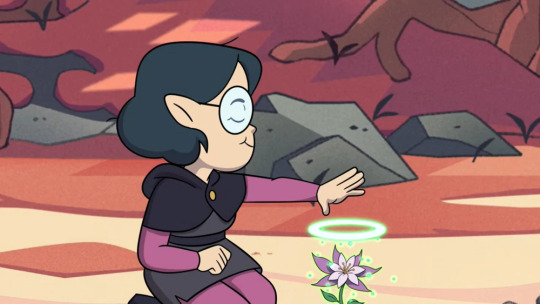
[id: a screenshot of Willow from "I Was A Teenage Abomination", depicting her sitting on the ground while casting a spell over a small, pink flower. /end id.]
I’m also not going to claim that the colour green Belongs To Aromantics, and therefore that All Plants Are Belong To Us, but in tandem with everything else I’m about to cover, the connection between Willow and plants seems like a fairly plausible nudge to a relatively common element of aspec humour.
“Half-a-witch” Willow and the Late Bloomer Experience
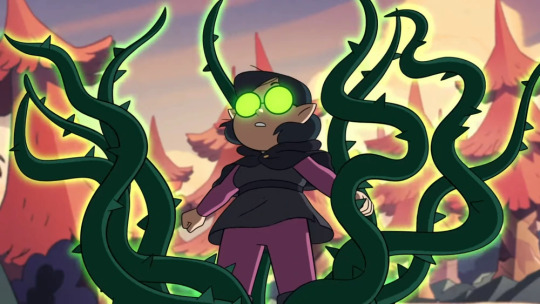
[id: a screenshot of Willow with glowing green eyes, from "I Was A Teenage Abomination", depicting her summoning a mess of thorned vines. /end id]
Willow is literally nicknamed “half-a-witch”, in reference to her supposedly incomplete state - this is a sentiment eerily reminiscent of the pressure to find one’s “other half”, which affects aspec - especially aromantic - people particularly profoundly. She’s considered a late bloomer, someone who hasn’t reached the societal milestones of growth at the expected age, and who is derided and considered immature as a result of this perceived failure. However, we quickly discover that Willow is, in fact, an exceptionally competent and powerful witch - taken out of the restricting frame of the Abominations track, she’s able to grow into her own, “complete” person, therefore proving that she was never really lacking in anything in the first place. Like real-life aroace people, she was perceived as limited and immature based on the expectations and judgements of other people, but Willow was never deficient in anything, least of all herself.
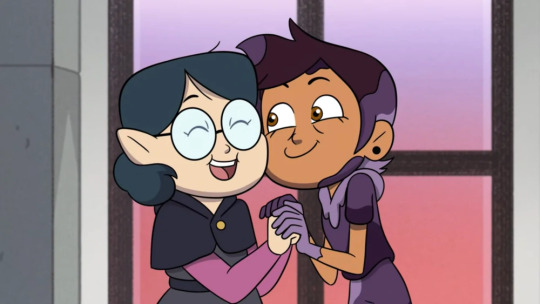
[id: a screenshot of Willow and Luz from "I Was A Teenage Abomination". They are holding hands - the former is laughing with her eyes closed, and the latter is grinning, while covered in abomination goop. /end id]
As far as symbolism goes...the track Willow is initially put in literally requires her to conjure up another humanoid entity, with the expectation that she will therefore prove herself to be a whole and mature person. Only with this ability, she’s told, will she be successful and happy as an adult. The shapelessness of her attempts at conjuring an abomination reinforces this connection in my mind - if I may reference this quote from Ducktales 2017‘s (absolutely stellar) A Nightmare On Killmotor Hill, in which the protagonists explore their own subconscious fears via. the dream realm, for a second:
“I think that’s supposed to be my romantic interest, but I’m too threatened by the concept, so it never takes shape.”
A lot of young aroace people find themselves in situations where they attempt to convince themself of their interest in someone in an attempt to be “normal,” or end up lying in response to family members or friends’ questions about crushes. While Willow’s abominations, first and foremost, represent the expectations from her school, classmates, and family to be a successful, “complete” witch with a profitable future, I think that with an aroace interpretation of Willow they could also very easily be read as representing some latent insecurities over a lack of attraction, or pressure to find a significant other.
(I’m not condemning Willow’s dads, by the way - they seem like perfectly lovely fellas, and I’m confident that they were doing what they thought was best for her. They’re certainly very quick to drop everything to assure her future in Escaping Expulsion, so obviously they care about their daughter very much.)
Greens, Blues, and Yellows: Colour-Coding Willow Park
A while back, I made this post comparing Willow’s palette to the aromantic and aroace flags:
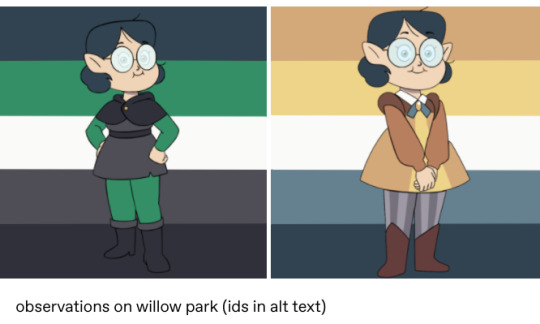
[id: a screenshot of a post depicting the aromantic and aromantic asexual flags, colour-picked from images of Willow in her Hexside uniform and casual dress respectively - these are overlaid on top of the flags. The caption reads "observations on willow park". /end id.]
The grey-and-green aromantic flag has long been the accepted mainstream symbol of aromanticism, and, as the above post - and many others - demonstrate, Willow’s palette reflects it near-perfectly. This could easily be a coincidence, owing to the palette of the standard Hexside Plant Track uniform, as well as her hair and eye colours - which are obviously supposed to be reflective of her plant-related abilities. However, given how fond of employing hidden meanings The Owl House has shown itself to be, I don’t think it’s far-fetched to claim that there’s at least a chance that her palette was constructed with the flag in mind.
The latter is...a bit more problematic for me, although it’s fun to joke about. The blue-and-yellow aroace flag was only created in December 2018, relatively late into The Owl House’s initial production, and it’s still relatively obscure, although on the rise in popularity as the accepted aroace flag (I only recently started using it myself), so I don’t know if Willow’s casual wear is enough to verify the presence of any deliberate subtext. I think it’s a fun coincidence, however, and (as was pointed out in this post) it’s cool that these blue and yellow stars surrounding Willow occur in the same frame as Luz’s bisexual decor:
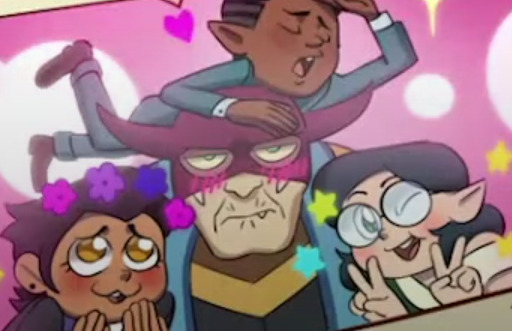
[id: a photograph of Luz, Gus, and Willow, all surrounding a disgruntled-looking Principal Bump. Luz has flowers in the colours of the bisexual flag decorating her hair, while Willow is surrounded by bright blue and yellow stars. /end id.]
also seen above: powerful bi/aspec solidarity
Conclusion:
Do I genuinely believe that Willow is being deliberately written this way? If you’d asked me, say, two months ago, I’d have said probably not - as far as queer representation in kids’ cartoons has come, it has a ways to go, and focusing on transgender characters seems like a more obvious (and equally invaluable) route to go down. I can name maybe five explicitly aspec characters off the top of my head, two of whom have been written as alloromantic and/or sexual in adaptations or continuations of the source material (I have...some grievances with 2005 Doctor Who). But the emergence of Raine, an explicitly nonbinary character on Disney Channel, has given me a little spark of hope, and so, even if it’s never confirmed, it’s comforting to be able to see a character with such strong elements of aspec coding and think to myself, just maybe, that there might be some intent behind it.
I also...really want to see interesting things done with Willow. We’re halfway through Season 2, and despite some promising setup for her arc in the Season 1 finale, she’s sort of been left by the wayside lately in favour of developing the more “plot-relevant” characters, such as Luz, Amity, Eda, and Hunter. Frankly, I think it’s a disservice to her Season 1 development, despite how much I adore all the characters I just listed - beyond any personal motivation, the prospect that Willow could be aroace adds a lot of sorely-sought depth to her, and, as detailed, a lot of this has already been set up in her earlier episodes. I just...I think it’d be neat. Rarely do you get a kids’ show so brazenly queer in its themes as Owl House, and aspec people deserve to be included in that.
Willow would also be great aroace representation because, well - those five or so aspec characters I mentioned being aware of are all white or “raceless” (...also written as white, basically), and so an aspec Asian character would be a really lovely step forward in this area. Additionally, all the characters I referred to are also conventionally skinny, and Willow is not only fat, but written in a way that doesn’t treat this feature as a caricature. People who are more knowledgeable on these topics than I are absolutely free to make additions, as is anyone who feels like I’ve left certain details out.
tl;dr: Willow’s association with plants could be read as a cool nod to aspec humour, her “late bloomer” narrative is eerily reminiscent of some common aspec experiences, her palette speaks for itself, and it’d be really cool if we could diversify the so-far fairly bland sphere of aspec representation.
I’m going to conclude this by linking Rose by The Oh Hellos, because they’re my favourite band, they share The Owl House’s initials, and I also think it’s a good Willow song. Peace out.
youtube
#the owl house#willow park#pspspspsps you will read my 1.5k word aroace willow essay#hooting#meta#willow#aroace willow manifesto#fuck it. this is getting posted
35 notes
·
View notes
Text
Neon Genesis Evangelion analysis chapter 21: Kaji Ryoji Lies and Silence
Hi, it's been a while. I'm sorry I disappeared for 5 months while working on the graduate thesis. From now on I will try to upload once every two weeks at 7pm on Saturday.
From here on out, the analysis will focus on the important characters of Evangelion with 15 chapters left to go. Thank you for your patience so far and I hope you all stick with me for the remainder of the ride.
Also, I realized that Tumblr now allows maximum of 10 photos a post, so I am thinking of moving or co-posting on a different site. I'll update all of you when that happens
================================================
Sakiel: The third angel, the first real opponent of Nerv. A portion of voice recordings of the battle attained
Shamel: The fourth angel, visual data gathered and backed up. Will send recordings of Unit – 01's battle against it.
Ramiel: The fifth angel, portion of remains attained and analyzed. Will send information about AT field.
Gagiel: The sixth angel, visual confirmation. Information attained from the UN. Will send information along with Unit – 02's battle data.
Israphel: The seventh angel, visual confirmation, will send data through channel 11-B. Attained sample of material composition
Sandalphon: The eight angels, confirmation through a still image. No further information
Matarael: The ninth angel, visual confirmation. Used the blackout to obtain a sample.
Sahaquel: The tenth angel, photographed attained. Will enter into the database through channel 57-F
Ireul: The eleventh angel, visual confirmation, data erased by Nerv. Will retrieve physically and send them over.
Reriel: The twelfth angel. Unit – 01 went berserk again
Bardiel: The thirteenth angel. Data attained from Mitsushiro facility
Zeruel: The fourteenth angel, visual confirmation. Unit – 01 went berserk. Will send video data.
---Excerpt from "The memos of Kaji Ryoji."
"2015: the Last Year of Ryoji Kaji" was written by the head scriptwriter Yamaguchi Hiroshi and was published in 1997. It contains Kaji's observations of various Incidents and set pieces in the series. It is not anything too particular; however, the fresh perspective Kaji's writings provide makes this an essential material in our understanding of the world of Evangelion. The excerpts mentioned above are essential proof of Kaji's identity as a spy and prove that the blackout during Matarael's attack was deliberately caused by Kaji and Seele.
Furthermore, it explains how Seele had attained information regarding Iruel's existence and its attack on the Nerv facility, even when Nerv/Gendou tried to hide this fact.

The memo above seems to be the observation of Nerv and the angels made by Kaji. While Kaji officially belongs under the Japanese government's command, as we have covered in Chapter 17, the Japanese government is unaware of Lilith's existence. It, therefore, has a different numbering system from Nerv and Seele.
Adding on to this point, the public in the world of Evangelion is unaware of the existence of Lilith. High-ranking Nerv officials such as Misato are aware of Lilith only as of the cause of the First impact and no more. Thus we can deduce that Kaji made the memo while he was on Seele's side, considering that he knew about Lilith in detail. But Kaji never once wholly and permanently sided with any organization. Like how his main character trait is a "flirt," he is never loyal to any organization, just like how he is perceived to be with women; two, perhaps three-timing.
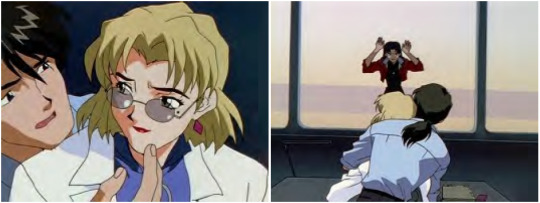
Kaji: You've lost weight
Ritsuko: Are you flirting with me? Stop. A scary-looking friend is watching.
However, it is wrong to say that Kaji was a cheater by any means. His heart belonged only to Misato, and she was the one he trusted the most. His flirting with Ritsuko and Maya made others view him as a superficial person and did not take him too seriously. This got some eyes off his back. This would have given him more freedom to act in achieving his goals (but also, it might have been fun to get Misato jealous in a playful way).
Kaji: Not like you are going to repay that. I added some dummy information in case.
Now, let's take a closer look at Kaji's actions throughout the series. He makes his first appearance in episode 7, having a phone call with Gendou discussing the Jet Alone (JA) program. Because JA was developed as a competition to the Evangelion projects, its implementation would have caused Nerv's authority to weaken and jeopardize the HIP. Making it a top priority to prevent its further development. Minus the actions taken by Misato, the proceedings of JA going berserk and being miraculously fixed were likely a scenario manufactured by Gendou.

Kaji: it has been restored up to this point. It is frozen in a thick layer of bayclade, but it is alive.
The key to the HIP
We first see his face in episode 8 on a new mission: Transporting Adam and Unit – 02 to Nerv headquarters. He likely attained Adam's body in Germany, stealing it under the nose of our dear old friend Keel. The question is, how did he do it? We will never know the details, but we know that Seele's projects that required Adam were complete at this point (Creation of Evas and Tabris). They may not have had much use or concern for the leftovers. Since Adam's fetal form is small, it would have been easy to swap the original for a copy before he left. Of course, this would not have gone unnoticed for long, and it did not.
In episode 10, we see Kaji talking to an unknown woman about the initiation of protocol A-17. It appears to be a measure that limits and shrinks Nerv's authority and freeze their funds. Just like the JA plan, it shows the hostility of the Japanese government towards Nerv. Because Nerv and Seele are still on agreeable terms, Kaji is seen as a double spy between Nerv and the Japanese government. But in episode 11, the Nerv blackout happens. With clues spread over the episode pointing to Kaji as the culprit with Seele's support, we begin to see him in action as a triple spy.
The reason why Kaji undertook such a dangerous role is to get closer to the "Truth." Upon realizing the Japanese government's imbecility, he begins to walk the rope between Nerv and Seele to seek the truth.
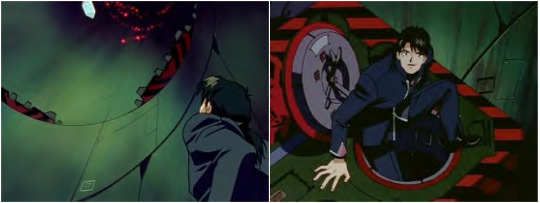
Kaji: Is that an angel? This is not the time to be doing my job
We first see him in action in episode 13 while the HQ was distracted defending against Ireul. Here we see him collecting information around the central dogma. While doing so, Kaji notices the angel while passing through the passage in level 28 and hears the announcement that the "Sigma unit (the Eva simulation chamber) will be shut off in 60 seconds. Bearing in mind that Magi is located in level 40 and that a lower number refers to a deeper level, we can see that Kaji has already infiltrated deep into the complex. As central dogma and Lilith were information that Nerv and Seele wanted to keep secret, this infiltration was likely Kaji's initiative. With the same logic, we can also say that the information he gathered regarding the Marduk institution in episode 15 was his individual action as well.
Later in the episode, he is found by Misato as he was trying to infiltrate the central dogma. But Kaji does not seem surprised by this fact and opens the door without hesitation. What they see on the other side was the white giant Lilith. However, we hear Kaji refer to it as Adam. Why? There are two possible explanations for this. First is that Kaji knew that it was Lilith but deliberately lied to Misato.
This explanation is weak at best. It contradicts the characterization of Misato being the only woman Kaji trusts. Further, it contradicts the portrayal of their relationship in the following episodes. It is also difficult to explain why Kaji would distinguish between Adam and Lilith in his explanation to Misato.
The other possible explanation is that Kaji believed this to be Adam, and I am personally more convinced of this explanation. As we have seen in an earlier episode, Kaji passed on the Adam sample to Gendou. Both were fully aware of what he has gotten into his hands (puns perhaps intended). Then why did Kaji believe that it was Adam in central dogma? He likely at this moment believed that the white giant was the manifestation of the Adam sample that he stole. Although it looked different, Kaji, who saw Sandalphon transforming at an unbelievable speed, would have drawn parallels.
Kaji's misunderstanding is also supported by the secretiveness of the existence of Lilith. The information being top-secret accessible only to the Gendou and Seele. Even when Gendou referred to Adam as "The first man," it could be him trying to misdirect Kaji on the identity of the white giants. Although the reason for this secretiveness is not apparent, we know that Seele was ashamed of their status as the descendent of Lilith, this being the reason for conducting the ritual of atonement.
The HIP Seele type is, in essence, based on the feeling of perceived inferiority against the Adam-based angels. Thus it can explain away why Seele would want to keep the project a secret from the public. Even without such reasons, Lilith's identity as a being in the same caliber of existence as Adam might have created a need to keep her locked away and kept secret. This to minimize unnecessary friction and interference in their plans by other organizations.
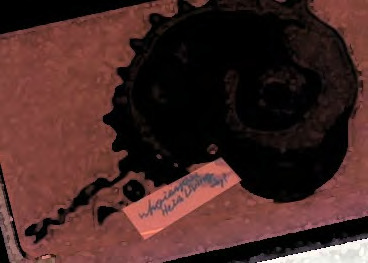
To add on, let's touch on the strange phrase written on the container of Adam's sample that Kaji brought over. "Who is you? He is living. Why?". There are no explanations given regarding this phrase. It is likely written by one of the researchers in the german facility that was studying this sample. Being the only remaining Adam sample that seemed alive with the absence of a soul, it would have been baffling to look at it.

This lie about the identity of Adam and Lilith is a recurring motif. In the earlier chapters discussing the angels' identity, I have mentioned that due to the enemies being the "Angels," Evangelion fundamentally rejects the narrative of Good triumphing over Evil. During one of the sequences in the opening song, there is a frame reading "ADAM," and it is unique as it is the only one that is black words with a white background. This likely foreshadows the fact that information regarding Adam that we receive is different, thus, at some level, inaccurate or lies.
Either way, the truth of the White giant's identity is revealed near the end of the series. The audiences are made aware of it through the exposition of Tabris. For Miasto, she receives this truth from Kaji along with all the information and data he collected by himself. Through this 'Truth,' we can infer what Kaji wanted to protect and what his 'will' was. This 'will' to live is passed on from Kaji to Misato, from Misato to Shinji, and influences his decision during the end of Evangelion.
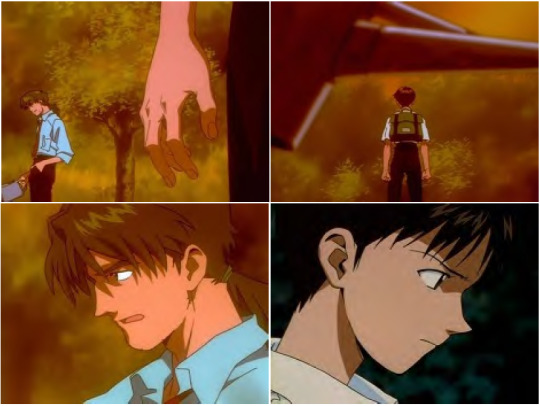
Kaji: Shinji, the only thing that I can do right now is to water these plants. And as much, there are things that only you are capable of accomplishing right now. No one is going to force you to do anything. Think for yourself. Decide for yourself. Determined what it is that you need to do right now.
So that you will not end up in regrets.
The alliance between Gendou and Seele began to show signs of schisms in episode 19 after Unit – 01 consumed Zeruel's S2 engine and became a being as though god. This was more in line with the plan of Gendou, who sought for the creation of a new god, the material conditions misaligning from Seele's plans of atoning for the sin of Lilith. Kaji was very much likely to have been aware of all this. When the schisms showed, Kaji had to choose the side he had to stand with. He seemed to have concluded that Nerv is closer to the truth that he wanted. Therefore he ended up helping Gendou achieve his version of the HIP.
I say this as Kaji played a crucial role in convincing Shinji to return and pilot Unit – 01 during the battle against Zeruel. Afterward, Kaji released Fuyutsuki, who was kidnapped by Seele, and began his pro-Nerv strategies. This leads up to his assassination by Seele's orders. To borrow Seele's words, "The bell around Gendou's neck lost its will to ring."

Fuyutsuki: Is that you Kaji?
Kaji: It's been a while.
Fuyutsuki: You will lose your life if you do this.
Kaji: I am just heading towards the truth that I believe in.
Let me talk a little more about his death. In episode 21 of the renewal version, an additional line was spoken: "They found out that I handed over Adam's sample to Gendou." This draws a line connecting the importance of Adam's Sample in Kaji's death and its role in the HIP.
Regarding the Assassin identity, due to the scene of Misato's grief being placed right after Kaji's death in "Death and Rebirth," some believed that it was Misato killed Kaji. One of the rare things that Anno came forward and cleared up was that Kaji's assassin was an unnamed individual that we do not see ever on screen. An additional argument made by those suspecting Misato as the culprit claims the evidence of interlaying of Misato's apartment door label right after the gunshot. This was later removed in the renewal version.
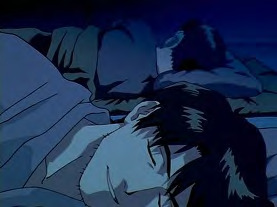
Kaji: No one can understand another person to a full extend. They can't even understand themselves.
But that is why people try their best to understand the other.
And that is what makes life such a fun experience.
Many of what Kaji says touches on the critical messages of Evangelion. It is also why I am starting off this section, the analysis of characters with Kaji; understanding Kaji is integral to understanding the series as a whole. He loved Misato but could not tell her his true feelings during the happiness of reunion after eight years. This was likely the greatest form of love that he could have given her, knowing that he is close to his death. The reason for Kaji's obsession with the truth and the sufferings he experienced in the past is fleshed out in detail in the comics version. He was orphaned as a consequence of the Second impact. After a failed attempt at stealing food from the military base, all of his friends were killed, leaving him alive and questioning the reason for their suffering and death. Kaji sought to avenge his friends by understanding why the Second impact happened.
But even without going into the details, we can try and understand the pain and suffering he went through as the generation living after the Second impact. Yet, his general attitude towards life and his ability to call living to be fun is his unique charm. He even managed to have a smile on his face while looking at the face of his death. His smile was not a forced fake that he made to mask his fear of death; he has probably smiled from the bottom of his heart.
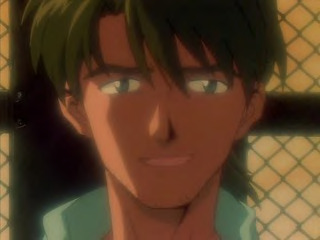
Yo. You're late
Because he would have already reached the truth that he worked so part to attain.
TBC Chapter 22: Katsuragi Misato Part 1 With a cross in hand
#Neon genesis evangelion#Evangelion#Eva#End of Evangelion#Nge#Nagisa Kaworu#Lilith#Sci-fi#Ikari Shinji#Soryu Asuka Langley#Asuka#Ayanami Rei#rei#Anno Hideaki#Katsuragi Misato#Kaji Ryoji#Anime#Analysis#Review
52 notes
·
View notes
Text
Lore: The Netherese in 1492 DR
Disclaimer Game Version: All these analyses were written up to the game version v4.1.104.3536 (Early access). As long as new content is added, and as long as I have free time for that, I will try to keep updating this information. Written in June 2021. Detail: BG3 takes place in 1492 DR.
To understand what's the context around "Netherese magic" and, let's hope, its nature, I think it's of vital importance to know a bit about Netheril and what happened in recent years.
The game does a good job in showing us what happened with their fall at Karsus' hands. I explained in the post of "Well-known Characters" a good amount of information about him. His desire for godhood was a bit more complex than just wanting to be a god, even though the game shows it as blind arrogance and ambition: so far we know, it was Mystra who commanded her priests to spread this version of Karsus' Folly, as if he only wanted power alone.
After Karsus' folly, all the floating cities of Netheril fell to the ground, destroying their population with them. However, only three cities were saved since they were too high in the air: their fall gave enough time for Mystra to be reborn in minutes and saved them. A fourth enclave, ruled by Telamont Tanthul—also called Lord Shadow—was teleported to the Shadow Plane (now called Shadowfell) days before the catastrophe. This was possible because Shadow Lord had been experimenting with the Shadow plane energies for a while. When he returned to Faerûn to see the aftermath of Karsus' folly, he recognised the need to stay in the other plane and gather strength to rebuild Netheril. After 1700 years, he started his plan for the return of his Civilisation in 1372 DR.
This is the context in which the trilogy of The Return of the Archwizards is set. This also belongs to 4e, which is one of the concepts that have annoyed more players, since this return made the Shadovars the Big Bad Evil everywhere. Maybe WotC wants to clean this aspect in the game. Maybe not. We don't know for sure. But we may suspect that Netherese people are returning in BG3: many details ingame keep giving context about them: Gale's explanation about Karsus' Folly, Excavation of the Enclave of Nhalloth (book), The Approachable East: Vol5 (book), and then the presence of Netherese magic not only in Gale's "orb" but in the tadpoles.
I think it's worth checking the ingame book called “Excavation of the Enclave of Nhalloth”. Nhalloth was a Netherese city floating above the Sea of Fallen Stars in Faerûn. After Karsus' folly, it sank into the sea, claiming for some underwater creatures. As a consequence of the Spellplague, the geography changed, the waters lowered, and allowed a bit of exploration. Little was found, and explorers reported odd feelings and ghosts around it.
What do we know about the Return of Netheril in 1372?
These new Netherese people started to spread their influence in Faerûn, looking for Netherese old artefacts and spying on people and places that could possibly hinder their ultimate goal of creating a new Netheril in their image. But, were these people truly Netherese? The question comes from the fact that living creatures can't stay in the Plane of Shadow (currently merged with the Plane of negative energy which transformed it into the Shadowfell) without being affected by it. So, in an attempt to be short but still provide important facts I will numerate vital details of them that may become handy in BG3:
This floating city used to be called Thultanthar, and after its return, it's more commonly referred as the City of Shade.
Somehow, the Netherese people survived, and became more united and secretive.
Over 1700 years, each generation of these netherese people become more and more attuned to the shadow plane, some of them even turning into Shades: twisted, dark, humanoid creatures with longer lifespan than humans. Lord Shadow was still the main ruler of the City of Shade because he is now a Shade.
A big percentage of their population are worshippers of Shar.
The archwizards (ruling class) in the highest ranks are called Shadovars. Not every Netherese or Shade person is a Shadovar. Despite this, most folk refer to all Netherese as Shadovar nonetheless.
Most Shadovars are followers of Shar.
Shadovars are masters of Shadow Magic. It's a common mistake to think that Shadow magic is the same as Shadow Weave magic. Shadow Magic is magic using the energies of the Plane of Shadow. This can be done using Weave or Shadow Weave. Since most shadow casters are evil-aligned, Shar tried to offer them the Shadow Weave as a means to cast their magic without using the Weave (an element of a neutral-good aligned deity). This is related to the effect of worshipping without consent: Using the Weave is always a way to worship Mystra even if the caster wants it or not. This always gives power to Mystra. Shar created the Shadow Weave as a way to divert all those evil-aligned casters into her own worshipping. More details in the post of "Mystra and her Chosen ones"
With the return of the Shadovars, they tried to corrupt the recently recovered Weave and turn it into Shadow Weave.
In 1487DR, Lord Shadow tried to gain the power of the Mythal of Myth Drannor, but Elminster killed him and the City of Shade fell upon Myth Drannor, destroying both cities.
However, this was not the end of the Shadovar. We may have some information about how they are in 1490s DR (let's remember BG3 is during 1492 DR):
Lord Shadow may be part of the Weave now (I have no idea why Ed said this. Lord Shadow was not a Chosen of Mystra, why would he be a weaveghost now?)
Two of his daughters and a Netherese arcanist survived: The sisters Lelavdra and Manarlume and the arcanist Gwelt have been calling themselves "The Three".
The Three have been collecting Netherese and others loyal to the Shade Empire from the ruins of the Citadel of the Raven in the western Moonsea region since late 1487 DR. They had collected at least 60 low level arcanists and 20 low born Netherese within a short period of time.
Gwelt was leading the hunt for others calling their group "The Court of the Three."
Their goals were supposedly to collect other Netherese, make allies, identify foes, take command of the remaining floating Netherese cities, and find a remote location to regroup and plan their re-emergence. It is unknown how far they have come.
Why all of this may be important?
Because part of this canon material may or may not be part of the story of BG3.
It's true that Larian has already changed some very consistent canon facts, such as the spell of the Hag eye (Ethel justifies her spell as a very personal customised one) or—the most impressive change—the Ceremorphosis process: Gale explains that the normal process removes the personality of the person in the sixth day after the infection, when in Forgotten Realms canon it should happen few hours after the infection. So my expectations for them to follow all canon material are not blind. They will change canon concepts as they think suitable, which is how DnD works. Still yet, it seems reasonable to read about all this in order to have a better context of what we will see, since the canon context is undeniably there.
Personally I always saw the presence of Netherese/Shadow Magic in the tadpoles as the intervention of Shar, but I never could find a group of mortals who would do that work and have such specific knowledge. We know that, with the exception of Mystra, contact with mortals is forbidden to all gods; therefore, Shar could not be the one to have approached these Mind Flayers. Now, the presence of the Court of the Three, working alongside or co-opting The Three Dead's plan seems a more reasonable possibility for me.
So far, what we know is that
Shadow Magic is equivalent to Netherese Magic ( EA, Ethel's words)
Shadow Magic is magic related to the plane of Shadows. This plane was altered by Shar when she merged the negative energy plane with it, causing the Shadowfell. The Shadowfell was Shar's realm for a while.
Shar was a great loser in the last edition. She could not change the Weave into Shadow Weave and become the greatest deity of magic as she planned. So she may want to counter-attack now.
Shadovars—who tried to help Shar in turning her into the Goddess of Magic—are masters of Shadow Magic and Shadow Weave magic.
The Shadow Weave was not destroyed, it's recovering at a similar pace to the Weave.
The tadpole can't turn the host into a mind flayer because Netherese magic (the dream person) attached to it works as a stasis process. ( EA)
The Netherese magic—aka dream person—seems to restrain the Mind Flayer transformation while having strong connotations of Bhaalspawn essence. ( EA)
These small details may suggest that maybe the Shadovar are returning, or the three dead are using Shadovar's knowledge or vice versa. The possibilities are many and it seems hard to decide which ones are more likely since EA gives little information for such estimation.
Sources:
2e: Sea of Fallen Stars 3e: Lost Empires of Faerûn 4e: The Return of the Archwizards, The Herald, Grand History of the Realms Article: After the Fall by Ed. Greenwood: https://dnd.wizards.com/articles/features/after-fall
Ed Greenwood Twitter
This post was written in June 2021. → For more Gale: Analysis Series Index
16 notes
·
View notes
Text
therefore i am but make it kevin day
alright here’s another song analysis for y’all. it’s kind of a jumble of thoughts, but maybe you’ll get joy outta it.
the song we are evaluating is ‘therefore i am’ by billie eilish. i think it’s a really good song for kevin @ riko. listening to it, i’m sure you’d get why, but i’m going to be extra and explain.
WARNING! will contain spoilers to the series (obvs)
let’s start from the top:
I'm not your friend
Or anything, damn
You think that you're the man
I think, therefore, I am
I'm not your friend
Or anything, damn
You think that you're the man
I think, therefore, I am
according to genius lyrics, this chorus means: “Billie confronts the people who want to control her and makes it clear that she has no regard for other people’s opinions about her.”
so it’s kevin after he’s finally escaped and if riko hadn’t died right after the game. it’s kind of like, a ‘what if’ of if they’d had to continue interacting.
he isn’t rico’s friend, brother, pet; anything. he is no longer forced to be tied to riko. “you think that you’re the man” could also be construed as everyone, including riko himself, seeing riko as ‘the king of the court’.
“i think, therefore, i am.” this part, again according to genius lyrics, is coined from Descartes. Descartes argued that even if we are skeptical about the existence of our physical body and environment, the self-conscious of mind still inevitably exists as “we cannot doubt of our existence while we doubt.”
to me this is a strong reminder to kevin that without riko, he is still someone. he still matters. he doesn’t need riko to succeed. he’s been part of a team for so long i’m not sure he remembers how to be his own person. but he’s learning. he belongs to this earth as the earth belongs to him.
Stop, what the hell are you talking about? Ha
Get my pretty name out of your mouth
We are not the same with or without
Don't talk 'bout me like how you might know how I feel
Top of the world, but your world isn't real
Your world's an ideal
i have no doubt that riko would spit countless bullshit to kevin to try to manipulate him into coming back, (he does it in the books and also most likely would have if he lived afterwards), not to mention lots of rumors would be spread by riko to try and tear kevin down. for instance, the fact that kevin’s hand was broken in a ‘skiing accident.” since we come from the perspective of neil, we know this isn’t true. however, the rest of the world doesn’t know that. so it’s like, “stop. what the hell are you talking about? literally none of this is true.” ie when he says he’s never gone skiing, but would like to someday. “get my pretty name out of your mouth and stop spreading rumors. with or without exy, we are not the same person. don’t talk to me like you understand how i feel, because you don’t.” (like at the interview). “you’re caught up in your own delusion. you’re on top of the world, but your world isn’t real. your world’s an ideal.” the “perfect court” that riko is striving for is simply that; an ideal. something he wants but would never in reality happen.
So go have fun
I really couldn't care less
And you can give 'em my best, but just know
he is finally letting go of the power riko had over him. he is letting riko go. he couldn’t care less what riko does, says, even fucking thinks anymore. the ‘and you can give ‘em my best’ could refer to him saying “oh ya say hi to the mafia for me’ lol, like a jab. sassy queen, we love him.
I don't want press to put your name next to mine
We're on different lines, so I
Wanna be nice enough, they don't call my bluff
'Cause I hate to find
Articles, articles, articles
Rather you remain unremarkable (Got a lotta)
Interviews, interviews, interviews
When they say your name, I just act confused
obviously this whole “splitting up the two exy stars” thing has spread all over the media; that’s why the ravens are able to switch districts. everyone wants to see them ‘fight’ one another on the court. but kevin LEFT. he isn’t a part of riko anymore. “dont want press to put your name next to mine.” the whole point is that kevin day is not #2 anymore, he is his own person. he is no longer defined by a number. #2 is no longer his personality but a number on a jersey; that’s it. “we’re on different lines,” they’ve always been on opposite sides even on the same court, always battling to be the best (yet it always falling to riko by default) but they’re finally on different teams. they have always been on metaphorical different lines, but this time, it’s actual different line ups. “so i wanna be nice enough, they don’t call my bluff” he acts so civil on kathy’s show even though he is literally shaking in fear because he was terrified more of what would happen if news got out. he wants to be nice and polite enough so that the audience doesn’t catch on that something is wrong. he hates to see articles written about them, hates to answer questions about them, because he wants to let go of riko. he doesn’t want his abuser haunting his recovery. “rather you remain unremarkable,” it would be so much easier, though, if riko wasn’t so popular. (then he dies but you know how it goes.)
I'm sorry
I don't think I caught your name
I'm sorry
I don't think I caught your name
i love love LOVE this part. i think it could be such a powerful line to kevin’s growth. riko is now insignificant to him. riko has no part in kevin’s life anymore. kevin can finally heal and become his own person. the ‘i don’t think i caught your name.’ strikes me as a sassy way of saying he doesn’t even remember riko, because riko is that forgettable. he can’t even remember that dumb man’s name.
so that’s it really, lmk ur thoughts!
btw, here’s my kevin playlist if ur looking for more songs i associate with kevin (: make sure to check my pinned post if u want more aftg character playlists!
8 notes
·
View notes
Note
How would u differentiate between value-form theory, the New Marx Reading, and what you call critical or nontraditional Marxism? Which ones are parts of or specific categories of which other ones
they’re all very intimately related tbh. i might not get all the history exactly correct but before the new reading was called the new reading in english (or even the NML in german) backhaus & reichelt referred to what they were doing as “value-form analysis” in their earliest articles. so there’s a sense in which VFT & NML refer back to the same intellectual beginnings and the same thinkers, but very quickly the two labels began to diverge a bit in terms of scope, as the NML came into its own as a particular interpretation of marxs work rather than just a couple of articles, finding some of its most important footing in the state derivation debates of the 70s.
on the other hand, and partly due to the growing attention paid to these debates, the term “value-form theory” became increasingly stretched around other people outside the initial circle of german scholars. in particular, the rediscovery of rubin’s work is important to note, but also the existence of decades of debate among japanese marxists who had also come to pay close attention to marxs section on the value-form (the work of kozo uno being most prominent). these were all understood as contributions to a more general discussion surrounding value-form analysis/theory which was set on a broader stage than the more exclusive german new reading.
but other than interpretations which had already existed, there was also the penetration of the german “new reading” into international discussions as it began to slowly get translated by marx scholars around the world, partly due to the shakeups caused by the publication and translation of the grundrisse and other works (thanks to MEGA) which forced many people to revisit marx with new eyes and making older interpretations more difficult to sustain. this is especially evident in that the majority of value-form theory was introduced to english-speakers thanks to a group of thinkers mostly associated with the then-lively conference of socialist economists that published in the journal capital & class. at the time, the group was finding itself increasingly fractured as the result of the recent explosion of sraffian/neo-ricardian literature, which for many seemed to imply the insufficiency of marxs theory of value and its necessary replacement by a price theory grounded in sraffa’s work. for many of the marxists involved, and especially due to the newly available grundrisse (as well as the slightly older but still shocking 1844 manuscripts), the image of marx-as-economist which sraffa was seen as outmoding did not match the portrait painted in marxs own personal manuscripts. a small chunk of the above-mentioned marxists in the CSE had semi-independently already arrived at a kind of reinterpretation of marx contra sraffa (mostly through hegel, a la chris arthur’s “systematic dialectics”, which for many amounts to the english-equivalent of the german “new reading”) but some of them were also capable of german and read or published translations of the articles written by backhaus et al, which immediately added some marxological fuel to the fire. diane elson’s article on the value theory of labor (and the eventual book she edited on value) was the result of this debate and was aided by the german scholarship.
so, although we can say that “value-form theory” really begins with the neue marx-lektüre, it’s often used as a more general term that actually stretches back before their initial writings and also outward to debates in other decades and countries. the notion of the traditional reading, however, belongs pretty exclusively to the NML and its offshoots because of its intellectual roots in the frankfurt school. it was horkheimer after all who first drew the distinction between traditional and critical theory and a very similar difference is what is suggested when we talk about traditional and critical marxism. for thinkers of the NML, like heinrich for example, traditional marxism refers to a kind of ricardian reading of marx which sees the project of capital as a kind of contribution to the eternal science of political economy, perfecting it and showing how it lends itself to the socialist cause. against this, the NML focuses on marxs project as a critique of political economy, a critique of an entire discipline/science. rather than perfecting political economy, marx is understood as radically negating it — interrogating its categories and showing the historical peculiarity of its social forms. this flies in the face of the way that marx has traditionally been interpreted and presented, from engels, to lenin, up through today.
as a post-NML theorist, generally associated with wertkritik/value-criticism, postone elaborated on an important element of traditional marxism which wasn’t as apparent in other critical marxist theory that came before. as for the NML, the important difference was in the perspective of the theory and what it saw as its real object, but rather than just a matter of affirming or critiquing political economy, postone situates the real difference around the affirmation or critique of labor, showing that the traditional ricardian reading was one which, through its bourgeois starting point in naturalizing the categories of political economy (since it saw itself as being part of PE and not critiquing it) neglected to understand the historical specificity of labor as a peculiar social object constituted by society and which couldn’t be understood in a merely anthropological/transhistorical way, as was common for marxists. marx himself alluded to this in his 1857 introduction, read by most for the first time when it was published alongside the grundrisse, which postone was explicitly building on. this meant that marxs theory was not a theory from the standpoint of labor and against capital, as if the two could be neatly separated, but an immanent critique of the system and therefore a critique of labor as the basis of capital. this of course wasn’t intended as a critique of laborers (just as the critique of political economy wasn’t intended as a critique of individual political economists), and marx obviously saw revolutionary potential in the proletariat, but this reading emphasizes the goal of socialism as being the self-abolition of proletarian labor rather than its realization at a higher level of social development, where the proletariat would come into its own and have the world for itself.
anyway this is long and probably more than you wanted but hopefully it clears some things up better than simple definitions would. and be sure to let me know if you want further clarification on any of this.
36 notes
·
View notes
Text
Episode 42 Review: Here Goes Peter Cottontail

{ YouTube: 1 | 2 | 3 }
{ Full Synopses/Recaps: Debby Graham | Bryan Gruszka }
At last, we’ve hit another milestone on Strange Paradise. A little less than a year ago, I discussed the third and final costumed flashback. Just under six months ago, we reached Episode 30, the first episode for which conclusive proof of executive meddling exists. And today we shall explore the introductory episode of a character particularly notorious among Strange Paradise fans. That’s right: this episode features the first appearance of the infamous Rabbit of Evil. The true face of evil has arrived on Maljardin, and it's soft with long ears and a fuzzy tail.
Because the plot has now split off completely from the Lost Episode summaries and I’ve already discussed the one for this episode, I’m going to ignore it for this post. I’m not even going to do much analysis this time. Instead, let us just lay out our beach towels on Maljardin, relax, and bask in the glow of the coming insanity.

Early morning on Maljardin. The unseen clock chimes three, and already Jean Paul Desmond is up sitting on the couch in the Great Hall next to the decanter of his favorite drink. Although it is the demon hour and almost everyone else in the château is asleep as far as he knows, he is already dressed in his brown velvet jacket, as one does when one is the richest man in the world on the coldest tropical island in existence. One would assume that he would at least loosen his tie to make himself a little more comfortable, but then, I’m not a fancy rich guy living in the 1960s, so what would I know?
Feeling the presence of his demonic ancestor Jacques Eloi des Mondes, he stands up and approaches his portrait as though in a trance. During their brief staring contest, Jacques begins to taunt him: “Come now, Jean Paul Desmond. Three o'clock in the morning and still you wander the house. Why?”
“Because your evil wanders here, Jacques Eloi des Mondes!” Jean Paul answers overly dramatically. “I sum-”
“Jean Paul, no oaths on your honor that you would be compelled to uphold. It might be the end of us both. And Erica might never rise to a new beginning.”
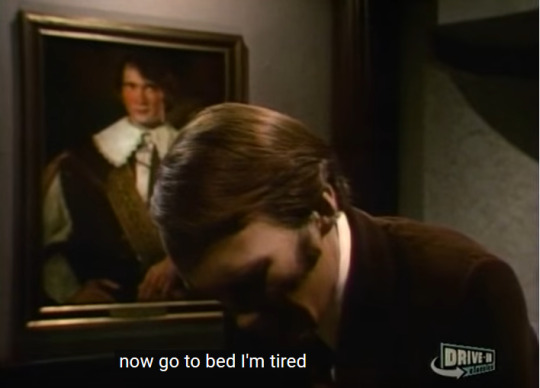
Jacques tells Jean Paul to go to bed because *he’s* tired. Could this be evidence that Jacques and Jean Paul are one and the same?

I like the way that Raxl's face appears on the screen just as the title card is fading.

Raxl paying her respects to Erica Desmond.
We cut to Raxl visiting Erica’s cryocapsule, when suddenly a little cockatiel starts tweeting. And who could it be but our mascot, the adorable Chalcko?
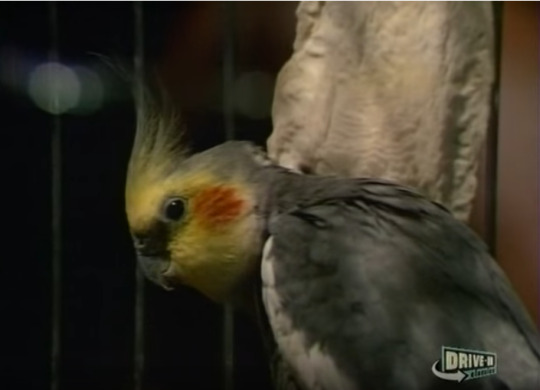
<<<<<<<<<<<<<<<<<<<<<<<<<<<<3

Quito checking on his beloved bird.
Meanwhile, Jean Paul visits the lab to find Dr. Alison Carr sleeping at her desk, Dr. Menkin’s notes next to her:

For the love of yourself, Jean Paul, do not disturb!
He wakes her up despite it being very early in the morning (because God forbid she not sleep in her own bed, I guess?). Really, there are only a handful of good excuses to wake someone up at 3 AM, including to ensure they catch an early flight and to kick them out of your bar after they passed out drunk with their glass shattered into a million pieces in front of the talking portrait across the room. Having fallen asleep at one’s desk while pulling an all-nighter that your employer deems unnecessary isn’t one of them, IMO. But, just like my cat who wakes me up around 3 almost every night crying for a midnight snack, he gets away with it because he’s cute.

Jacques has made cat-like faces before on this show, so now it’s Jean Paul’s turn to act like a cat.
That’s not to say that Jean Paul’s cuteness makes Alison any less annoyed with him. He asks her why she stayed up so late to study the notes, and she responds, “I can't sleep very well, anyway, and what else is there to do, since you keep us here as prisoners on this Island? Good night and please don't disturb anything.“ She leaves and he starts flipping through the notes.

Meanwhile, outside among the suspiciously Canadian coniferous trees of Maljardin...

Wait for it...
Quito finds a big, fluffy black rabbit hopping around the garden and brings the adorable, plump creature inside. His crush Holly happens to be in the Great Hall when he returns, and she falls in love with the rabbit at first sight.

“I didn't know anything as wholesome and innocent like that existed on Maljardin,” she coos. "Oh, he's so sweet! I haven't seen anything like him for--well, it seems like a whole lifetime.”
Then she remembers what Raxl said about there being no wild animal life on the island. “But Quito,” she says, “Raxl said like, nothing like this could exist on this island for three hundred years! I guess this little fellow disproves that, doesn't it?”

“What are you going to do with it?” she continues. “I mean, are you going to keep it?” Quito shakes his head. “You should. You should keep it for a pet. He’d make a lovely pet, something nice in this house of accident and death.” Because Quito is reluctant to keep the rabbit and has no way of expressing why to Holly, she offers to keep it as a pet.
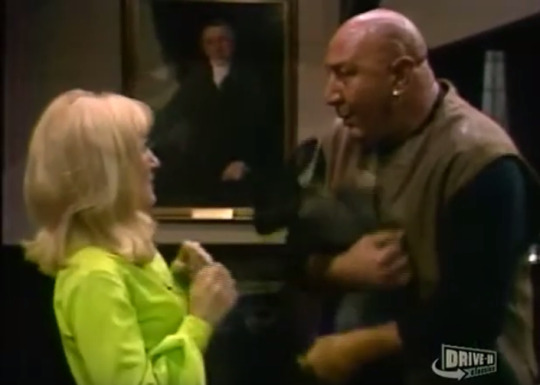
“I wonder how he managed out there with all that poisonous undergrowth around?” she thinks out loud, as the rabbit starts to try to jump out of Kurt Schiegl’s arms, which I doubt was in the script. The rabbit they got to play the new embodiment of evil on Maljardin doesn’t always want to behave the way the plot demands. I suspect that, instead of getting a trained animal actor, someone just brought in their pet or bought a bunny on short notice at an Ottawa pet store or nearby farm. I like the rabbit. The rabbit does what it wants and doesn’t give a rat’s ass about following the script or doing what Jerry Layton wants it to.
Holly asks Quito to make her a cage so that she can keep the rabbit in her room, and he nods in agreement (I’m guessing just because he knows it’ll please her). He leaves. She sits down at the dining room table and rings for Raxl, who is not pleased when she tells her about the new guest:
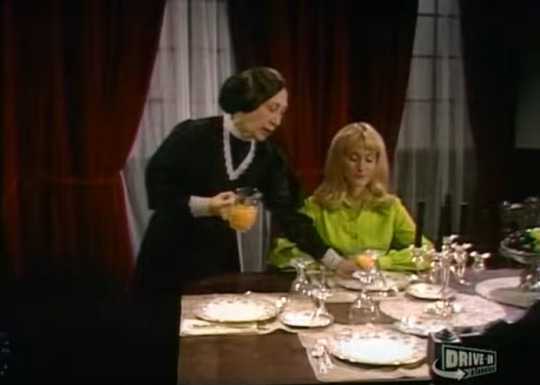
Holly: "Hey, Raxl." Raxl: "Good morning, Miss Holly." Holly: "You know, everything I've heard about this island isn't the truth." Raxl: "Truth is a matter of seeing." Holly: "Well, I've seen. You told me that because of the curse, nothing could exist outside in that poisonous jungle." Raxl: "The Devil's evil is everywhere on Maljardin!"

Holly: "Well, just this once, Raxl, you may be wrong." Raxl: "It may be that demon wants you to think I am!"
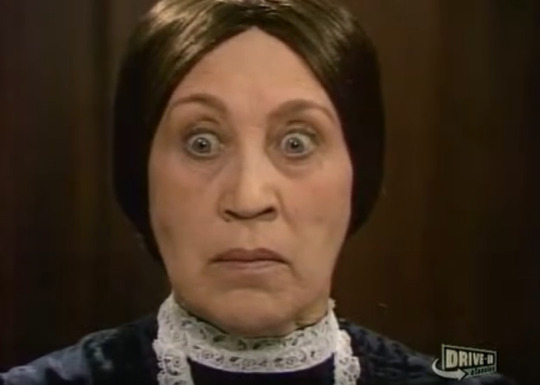
Raxl instantly suspects that the rabbit is a tool of THE DEVIL JACQUES ELOI DES MONDES.
The bit about all the plants being poisonous on Maljardin, by the way, may be a retcon. In Episode 13, Jacques mentions that papayas are native to the island. I suppose that, because he didn’t say that they were picked on Maljardin, that they could have been grown on another island. Still, I’m not ruling out the possibility of Ian Martin and/or a ghostwriter retconning this detail.
This scene is followed by a cool shot where the camera pans along the side of the staircase and over to Jacques’ portrait (see the beginning of Part 2), then a short scene of Quito pulling out a huge wicker picnic basket for a makeshift cage while Chalcko tweets as though trying to warn him of the evil presence.
In the morning, Alison returns to the lab to find Jean Paul in a scandalous state of undress:
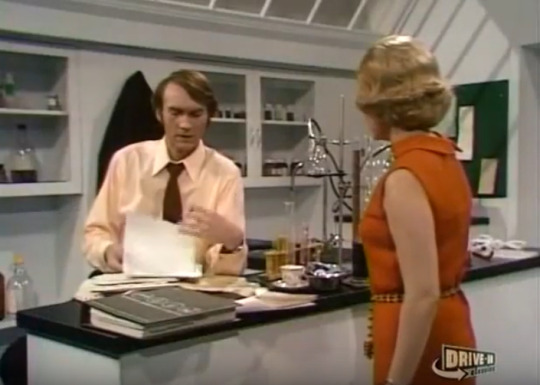
Ye gods! He took off his suit jacket again! I am SHOCKED and SCANDALIZED by this wanton display of nudity! ;)
Jean Paul must be even more stressed now than last night if he not only has his suit jacket off, but has also loosened his tie. Turns out he ended up pulling an all-nighter himself in the lab reading the notes, even though Alison doubts that he possesses the necessary knowledge to understand notes about cellular reconstruction. Jean Paul asks Alison if Dr. Menkin did any experiments on animals, but it’s not clear if he’s asking just out of curiosity, because of something mentioned in the notes, or if somehow he feels the presence of the rabbit despite not having seen it yet. Whatever his motivation, the screenwriter almost certainly added the line to imply that the rabbit may have belonged to Dr. Menkin.
Using such a line as a hint (or, more likely, as a red herring) is a very Ian Martin thing to do, so I’m thinking that he must have written this scene. For a while, I suspected that perhaps some ghostwriter hired by either Jerry Layton or Steve Krantz inserted the scenes with the rabbit into a later draft, but now I’m having second thoughts. While it is possible that one of the showrunners hired a ghostwriter to speed up the script edits, this line has Martin’s influence written all over it. The insertion of the evil rabbit isn’t his style, but this kind of dialogue certainly is.

Also note that the very next shot is of the rabbit again.

Hearing the bird tweet is making Quito anxious. It’s obvious that the bird detects some sort of presence.
Jean Paul and Alison go to the dining room and sit down for breakfast with Holly. Jean Paul reminds her that another séance is coming and she tells him that she wants no part of it. “The spirits will decide that, and the Conjure Woman,” says Raxl.
“Vangie said that the conjure cards--the Tarot cards--spoke to one person,” Jean Paul adds, flubbing his line adorably. “They may well speak to another, for or against.” I’m not sure what he’s implying, especially because he faces Alison (or maybe the Teleprompter) as he delivers the line.
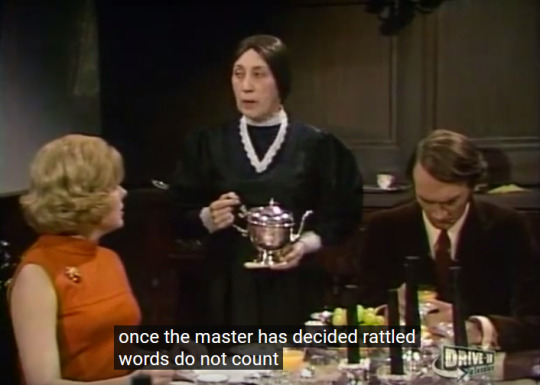
More proof that Maljardin is no tropical paradise, but a dystopia. (”Rattled” = “Raxl’s”)
Alison tells Holly that Jean Paul will probably blame them if the séance doesn’t bring him into contact with Erica and Jean Paul glares at her before flouncing passive-aggressively. I’m so conflicted about Jean Paul at this point because he’s becoming more and more of a control freak (and therefore more and more unlikeable), and yet he’s so adorable. Take a look at the face he makes just before flouncing:

Foxy!
And this shot of him from earlier in the scene:
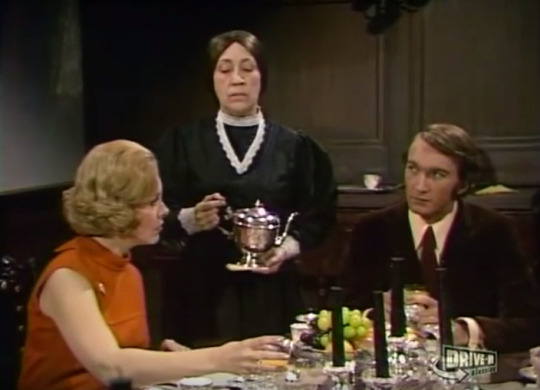
Never have I seen any guy look this cute after pulling an all-nighter.
Holly tells Alison about the rabbit Quito bought brought her (yes, there’s another creative line interpretation). “That’s impossible!” she replies, stunned. “I mean, nothing alive exists out there now.” There are so many flubs in this episode that it makes me wonder if the actors had less time to rehearse than usual.
An unspecified amount of time later, Alison catches Jean Paul arguing with Jacques’ portrait, then Quito feeds the rabbit a carrot to the sound of more tweets. (Anyone else miss the days when “tweets” referred only to the noise that birds make? God, I'm barely 28 and already I feel so old.) Alison warns Jean Paul that dabbling in the occult is bad for his mental health, but he doesn’t care because he needs to hear Erica’s voice so badly. He tells her he’ll buy her some animals for her experiments the next time he visits the main island just to shut her up. (Spoiler: He won’t.)
And then Quito arrives, carrying the rabbit in its makeshift cage. Like Raxl, Jean Paul is not pleased to see the animal. “Holly, where on Earth did you get that!” he asks.
“Right on this Earth, on this island, from Quito,” she responds innocently.
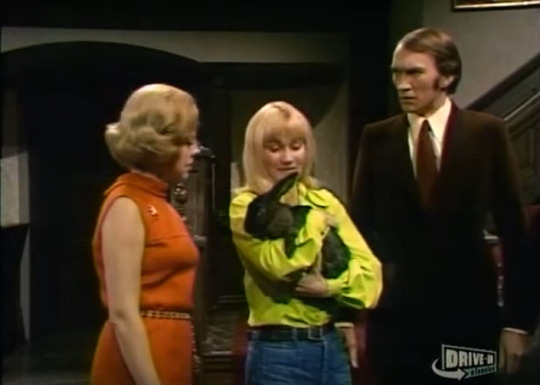
Jean Paul giving his best “WTF” face. He’s lived on the island long enough to know that the rabbit came out of nowhere.
He asks Raxl about it and she cries out to the Great Serpent to tell her what the Devil’s plans are for Maljardin, making the Sign of the Great Serpent with her hands. Alison insists that the rabbit is only an animal, but Raxl reminds her that no animals can survive outside on the island--meaning, by her logic, that it must be a demon or similar evil being!
Jean Paul asks Quito where he found the rabbit. Raxl interprets the signs he makes as meaning “on the path to the boathouse,” which leads Holly and Alison to think that the rabbit must have snuck aboard Quito’s boat and sailed there with him. Raxl’s response?

Raxl: “It is a creature of the Devil!”
Holly objects and insists that the rabbit is only an animal, but Raxl sticks to her belief that it’s actually a demon assuming the guise of innocence, most likely sent by THE DEVIL JACQUES ELOI DES MONDES himself! No one believes her, not even Jean Paul:
Jean Paul: "I must admit, Raxl, this is very unlikely." Raxl: "Not here. An animal here is an impossibility. Is that not true?" Jean Paul: "Until now, yes!" Raxl: "Then what force altered the impossible? There are forces at work on Maljardin as the hour draws near when the master will attend a séance and seek through purified mind and cleansed spirit to reach his Erica beyond the veiled curtain. What does the master say?"

Jean Paul does not respond. He looks like he is about to cry.
Raxl: "Quito! You will remove the rabbit. It is evil!"
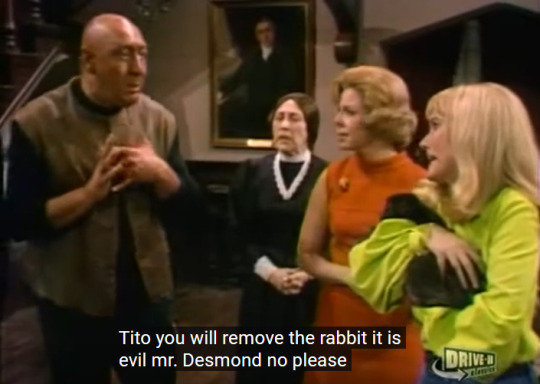
Raxl: "It brings danger and wickedness and more evil than we will ever know! It must be destroyed and buried in the sea!"
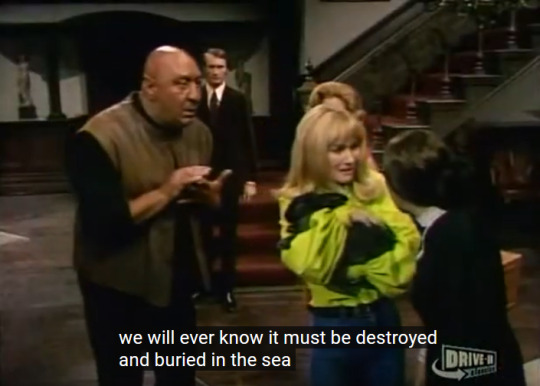
Raxl: "If the master wishes to contact his Erica and hear her voice, he will be advised: that animal is evil!" Holly: "Mr. Desmond, please, no!"
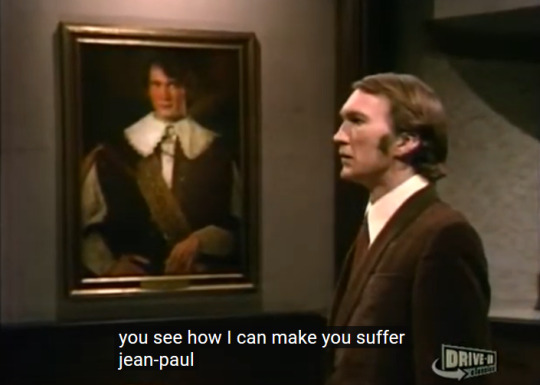

Jacques’ commentary.
Coming up next: Raxl makes a horrifying--and mystifying--discovery when she examines the Rabbit of Evil.
{ <- Previous: Episode 41 || Next: Episode 43 -> }
#strange paradise#now an even stranger paradise#review#ian martin#maljardin arc#week 9#episode 42#analysis#chalcko (quito's bird)#colin fox in shirtsleeves#costumes#creative line interpretation#passive aggressive jean paul#rabbit of evil#retcon#scene transitions#scenery chewing#sign of the great serpent#note to self: find a recipe for papayas with lime juice and post it
1 note
·
View note
Text
Sigh...
I had Allurance for a moment only for vld to make it a ghost ship with Lance now forever pining after Allura's death.
Shiro was finally able to be the "White Paladin" of the team but he barely interacted with them or even looked at Keith.
Hunk and Pidge had amazing screentime but Matt and a few others got sidelined and forgotten.
And Keith? He apparently wasn't even in Shiro's "wedding" with that rando--Curtis--even though he pretty much has been implying since s1 that Shiro is his family and his guiding light so therefore someone he would always be there for especially in his ups and downs of life.
Sheith held on all this time only to act like coworkers in the finale but not anything more like they have forgotten how to be best friends until it was convenient for the plot.
And Allura? The girl who lost everything? She ended up being almost like Honerva--sacrificing everything that is her to help her new family get their happy endings even though she could never attain hers.
I loved the fighting, the mecha transformations, the development of the MFEs, the plot, and the final showdown against Haggar but--
--To give Lance and Allura happiness and hint on giving her a new belonging only to stripe it away as a "price" all while "subtlety" diminishing Keith and Shiro's importance to each other to make their disjointed individual endings "make sense" outside of their s1-s7 buildup and somehow mesh both ships to fail in the end as a "this was the only way to save the universe" ploy-----
--Despite the damn show constantly paralleling the lesson on how Zaggar's love turned to a twisted hate that destroyed the universe and it was up to literally Allurance and even Sheith's love that actually saved the galaxy throughout the series--
----Only to rip both ships off as a sacrifice to satisfy the plot just enough to "justify" their demise as a means to an end. That metaphorical 'smoking gun' we expected to go off at the end? Over Allurance and Sheith? Was nothing but an illusion and wasn't even loaded to begin with apparently.
It is aggravating and disappointing.
I really loved this whole season but that last episode completely went against it's own theme.
They wouldn't have let Allura sake herself let alone let her do it alone--even with Honerva.
Lance wouldn't have even accepted the thought of Allura with that dark entity in her for long or even allow her to die or even worse be forced to love her ghost for the rest of his human life.
Allura wouldn't have wanted Lance to pine after her and not move on from her. She wouldn't have asked that of him by giving him her marks as a way of keeping a part of her quintessence in him.
Keith wouldn't just estrange himself from the one person that made up his whole universe especially after his oath to Shiro of always being there. He, at least, should have been the best man in the wedding if he was the selfless type to watch the canonical love of his life get with someone else.
And Shiro? He wouldn't have remained sidelined til the very end when they only needed him for his Atlas to only help boost Voltron and he clearly, while became a pseudo-Paladin for a moment, did not make any direct change or impact on the 6-man team. He especially should have had a direct moment of any form of romantic attraction with someone in the show and not as a damn fucking footnote of a "One Year Later" offscreen and unwritten romance with a character we didn't even know the name of at first nor should Shiro's final arc be seen as a "oh btw he got married and retired? Idk we keeping it vague so we give you lgbt rep!"
Despite the clearly, already written in the show, deeper bond he has had with Keith since even before s1 and that now makes his supposed bond with Keith a moot point and now unnecessary since it did not deliver in any way or reach a pinnacle in the climax nor did it have any proper closure to even indicate whether it could have or couldn't have been in the first place.
I have a lot of amazing points I would have shared earlier if I hadn't watched the last episode but that last scene completely turned the whole s8 around it's own head and practically told it to go fuck itself.
They try to amend it with a cheap superficial "Praise Allura Day" and despite a few of the team indeed having some form of ending--the main cast which consists of Keith, Shiro, Allura and yes Lance too by his association with her as her boyfriend--was literally given the short end of the stick.
Keith was sidelined and not allowed to act but be an observer at the end with none of his usual prowess, Lance now forever will chase after Allura's ghost and be haunted by her, Allura, herself, died for literally no reason than to right Honerva and Zarkon's wrongs, and Shiro wasn't allowed to even be a part of his paladin family and only there to remind people--at the last 5 seconds--that he's gay and apparently not single anymore with literally a no-name guy (actually it's Curtis but I had to look that shit up) that looked too much like Adam for my liking and while completely disregarding everything he did for Keith and vise versa.
Man that last episode is like Bleach's last chapter.
A completely different almost rewritten reality from the entire series itself. It overturned all the canonization of seven seasons under one episode.
And whether it was DreamWorks or JDS & LM's doing is irrelevant.
While it was an incredibly impactful season it did it with a fucking high cost.
Not about the ships per say--except Allurance for why make it happen only to destroy them immediately later?--but rather the complete turn arounds it had to do to try and justify why they made it that way.
That is what's so aggravating and disappointing.
Not the plot.
But the writing standpoint of trying to explain plotpoint A to upside down B. In a way, they became Haggar themselves and rewrote B and inverted it to make no sense whatsoever but pretend that it was "the only way" for it to end.
I expected an open ending for Sheith or actual development of Keith with Acxa and Shiro with Curtis if need be--and it had to be extremely good--but they couldn't even do that right.
And Allurance? They planned for Lance and Allura since the beginning but apparently the price Lance had to pay for his happy ending was her life out of the blue and at the last second.
And that hurts me.
This isn't as bad as Bleach's notorious ending but this is a definite close second at how they completely turned things around to try and make the ships happen just so they can fail while preaching how the theme of vld is found family and true love saving the universe.
Too bad the main trio--plus Lance now too--weren't allowed to partake in that lesson or in true happiness.
I still love Allurance and I will always love Sheith.
But what they did to Allura and Shiro completely ruined both Lance and Keith's endings.
And that breaks my heart to see it as the price they paid for daring to love them and trying to make them happy.
Lance can't truly be happy now since he can't move on and let Allura go or rather he won't to keep her memory alive in him.
And Keith didn't even get to watch the man he loved get with someone else and is now estranged from his best friend he swore he loved so much he literally was willing to die with Shiro and allow the universe to pay for it.
And what of Pidge and Hunk? We know what they accomplished but what about their personal lives? Is Hunk with Shay? Is Pidge still single? Is Matt still with his girlfriend? What of Acxa and the others? It is so vague with no clear answer and that is also disheartening.
Ah, sorry for my ramble. I stayed up to watch it from 3am and it's now almost 9am as I finish typing this jumbled vent post.
I'm both happy it's over and saddened it ended that way. While I didn't expect Sheith to happen I never imagined it like this and while I hoped for Allurance I didn't want them to pay the price for loving each other to the point of ending them.
I'm sad but I won't take it out on the writers--idk if I trust them at the moment--but I am still grateful they gave me Shiro and so many other characters to love.
I just hope they understand what they did and how much they disappointed nearly everyone with this "twist" ending.
Imma go sleep now I still have a lot to process.
I thought we'd get to see them all get happy endings but apparently only half of them did.
And last but not least no one suffered more than Coran when he found out--I feel so broken for him the most since he couldn't keep the promise to King Alfor to keep Allura safe--which is what his whole point in life was and what defined him as both a mentor and father-uncle figure to Allura and his new family.
And I think that's the one that hurts the most.
Okay I'm tired and sleepy so I'll be sure to interact with yall later for better analysis of s8 when I'm in a better state of mind.
Peace out yall.
Edit: Keith apparently IS in the wedding but he’s literally behind Shiro the whole time that it took me a few rewinds to see his ponytail and slight show of his profile. Geez way to hide him from the camera angle DW it almost made it look like he wasn’t even there if you didn’t pay attention behind Shiro and gave us the impression he wasn't there to begin with.
205 notes
·
View notes
Text
Ships & Fandom from the view of a literary theory student: My thoughts on the “Drarry War”
Recently, members of the HP fandom from all backgrounds that I adore have been fighting about the treatment of ships (notably Drarry) in the HP fandom. Lack of respect, listening, and communication resulted in hateful messages being sent to several members of our fandom. The extent of this blatant disrespect and arguing has caused the interaction to be dubbed, “The Drarry War.” Though it seems as major players have thus apologized, I’d still like to voice some of my thoughts which I believe are relevant in order to make sure nothing like this happens again, and that our shared fandom remains a peaceful, safe, and respectful place for creativity to flourish.
My opinions on this matter are based mainly in the literary theory class I took last quarter. Acknowledging the fact many of you have probably not taken a class in lit theory (I 10/10 recommend it, though), I would like to preface this explanation with some context. Before Post-Saussurean linguistics erupted in the 20th century, there were three main figures which influenced how readers consumed literature: the author, the text, and the reader themselves. The relationships between these three elements dictated and differentiated the earliest reading styles which are still used today. The first was expressive realism, in which the author had some sort of “inward eye” or special trait of artistry that readers did not attain. The text was the vehicle in which the author’s message could be given to the reader. New criticism, the next practice, discounted the author all together. Once the text was written, the text held it’s own meaning, and readers drew conclusions only from the words on the page. In both of these, the readers were “ideal,” meaning they were passive consumers of text that were basically spoon-fed material and expected to agree with it wholeheartedly. Reader response, the third reading practice, discounted this entirely. It stated that readers determine the meaning of the text in social groups, allowing for creativity and originality not only in analysis, but in recreation. Reader response is therefore the origin of fandom by allowing fanart, fanfiction, and roleplay to exist as legitimate functions of analyzing text.
I mention these not to bore you or prove how much I learned in English 202, but to point out the main issues I see occurring from a literary theorist standpoint when fandoms hate on non-canon ships (or non-canon-discounted ships). There are two more so foundational issues I see happening: the glorification of canon and the deconstruction of fandom, both of which are extremely detrimental to fandom flourishing the way we want it to.
The glorification of canon is rather self-explanatory. However, the issue that occurs in this, tying it back to literary theory, is that glorifying what literally exists either promotes expressive realism or new criticism. Because paper and ink are inanimate objects, I will solely focus on expressive realism’s toxicity in this matter. Only believing what the author has proven to be true as valid is an extremely new critical approach to reading. The issue with this is, more often than not, authors are prone to problematic views based on their own historical context. We all know this holds true with JKR: from her forcing together of non-compatible characters into straight romance and her lack of non-discriminatory or offensive representation, we understand her historical context is extremely cishet and white. Therefore, only going along with what she gives in canon will inherently lead to ships being the same. Fandom is the place to explore alternatives, giving people the representation they lack. Only upholding ships that coincide with the author’s views are therefore dangerous, as every author has biases that should be questioned and challenged as we begin becoming a more open-minded and inclusive world.
But, more jarring than that is what will happen to fandom if such “civil wars” over ships keep occurring. As I stated previously, fandom exists because readers took meaning from the author and decided what it was by themselves, creating it through different mediums. The opposite of this is therefore only adhering to canon ships, as it represents expressive theory. This is the base of the issue: expressive theory and reader response cannot exist at the same time. Because both have different opinions on who decides the meaning of text, they are fundamentally destructive towards one another. Therefore, when individuals hate on ships which are non-canon, only believe in canon ships, or do both at the same time, they are destroying the targeted person’s ability to participate in reader response by promoting its opposer. By saying the fanfic writer/fanartist/roleplayer cannot conceive relationships in fandom because they are unhealthy in canon, anti-ship fandom groups are not permitting the creative analysis that defines reader response to exist, demolishing reader response as an appropriate way to respond to literature. Because reader response is the foundation of fandom, it can therefore be concluded that by disproving non-canon ships and taking away reader’s creative response forms, members of fandom are actually deconstructing the fandoms they are in. Yes, you heard me correctly: by hating on Drarry (or any non-canon ship), you are going against the very foundation of literary theory that allows fandom to exist by saying what happened in canon is the only reliable bases for determining compatible pairings. It’s not just about creative expression being what fandom is “about,” but what allows fandom to exist, and exist in the way it does. By hating on a non-canon ship, you are going against the same rights that allow you the freedom to reform any characters or plots that do not belong to you. The right to write fanfic, to draw fanart, to do role-play, make fan theory videos, you name it.
This, in my opinion, is the true issue with fandom “civil wars:” they are demolishing fandoms altogether, not only from ruining good-will, but not permitting the foundation of fandom to exist. Yes, the beautiful part of fandom is it’s creativity, but that’s also the necessary part of it. It’s more than just difference is what makes fandom unique. Without allowing fans to ask, “what if?” and stray from the canon, we would essentially be promoting a literary theory that disproves the foundation of fandom itself. We would be destroying ourselves. And, from what I’ve read about this “civil war,” we have already been doing so for a long time.
If you’ve held on and have read this analysis to this point, you probably have a question I am anticipating. Yes, I am a Drarry shipper. And a Wolfstar shipper. But also love Jily, Romione, and Remadora. For a long time, I’ve wondered how I can love Remadora and Wolfstar at once. My analysis answers this question: I am truly promoting fandom by not allowing what happened in canon discount what can happen in head-canons. But I don’t mean to toot my own horn; there have been plenty of times in which I have hated on ships on Tumblr (I mean, just look at my “pairings I will not write for” list; it’s pretty blatant) and in conversations with my mutuals. If we want fandom to survive and thrive, this needs to stop on all levels. Especially when it gets as toxic as demeaning the actual people behind the computer screens.
I know this fandom means so much to every single member of it, and I am sure we would ache to see it crumble into pieces from our own wrongdoings. It is never too late to learn from our mistakes and apologize for them; these are the mature actions that were demonstrated by so many of the big blogs who, by choice or force, fought in this “civil war.” So please continue to be mindful in the way you interact with those who have different opinions than you. Remember: it is those differences that make fandom possible, regardless of your distaste, so please at least respect them for the role they play in the foundation of fandom itself.
Also, if you do only ship canon ships, I do not mean for the “glorification of canon” section to peg you as someone homophobic or anti-POC. I just want to remind us all of the imperfections of authors, and, therefore, of the content they create in order to stay mindful that we have the power to bring more representation and non-offensive representation to the table. And, of course, we have fandom to thank for that.
A/N: I would like to end by saying this post is targeted towards no one in particular and everyone at once. We all need to work together to make our fandom inclusive, kind, accepting, and strong, and these are ways in which I believe we can accomplish such goals.
4 notes
·
View notes
Link
10 Years Later, Taylor Swift’s ‘Fearless’ Still Slaps
When it was released in 2008, Swift’s sophomore album launched a thousand takes. Today, it’s best remembered as a simple time capsule
By LAUREN M. JACKSON November 12, 2018

Taylor Swift during the "Fearless" tour at Madison Square Garden on August 27, 2009 in New York City.
Theo Wargo/WireImage for New York Post
Like Propel water, The Scarlet Letter and mechanical pencils, Taylor Swift’s Fearless pairs well with the sporadic squeak of team-issued sneakers, overpriced hot lunches and the kind of angst that defines comfortably suburb-bound teenage years. Sliding open the album on Spotify with my iPhone 8, I can still feel my limbs stretched in all directions, hear the snap-crackle-pop of a dozen adolescent girls’ joints going through the motions of yet another warm-up to what would become the soundtrack of my high school varsity dance team’s inner and outer lives, as well as leave poptimism forever changed.
I am 27 now, still anxious but inflexible, no longer clinging (as) tightly to singular albums to tell the emotional landscape of my life — but back then, Fearless was god. Swift was barely into legal teenagedom when compiling her sophomore album’s original 13 tracks, but more than the happenstance near-synonymy of our ages (I’m younger by 1 year, 6 months, 27 days), the four-walled, high school claustrophobia induced by the album is a matter of skilled musical mood setting. From the first downbeat of the inaugural title track to the last flippantly rebellious “hallelujah” on “Change,” Swift traps us in the mind of an ungainly teen as she was once trapped, as I was, as so many others wading the ambiguity between comportment and desire that doesn’t quite end when gowns come on and caps fly up.
Like so many notebook pages on the golden screen, Fearless is filled with boys. Stans and haters have their theories, but I like to think of each song as an archetype, less true stories of relationships gone sour than a young woman’s true to life hetero-ethnography. There are the boys who do good — the “Fearless,” “Love Story,” “Hey Stephen,” “The Best Day” boys (the last a tribute to Dad) — the boys who nurture and love intensely. They do all the usual country boy things, all the usual cinematic things: driving slow, kissing in the rain, flouting archaic inter-familial squabbles. They honor their promises and, most of all, leave the narrator better changed for her affection.
These boys who do good are short-lived. By Track 2, “Fifteen,” we’re already checking in to Heartbreak Hotel for the upteenth time with an account of that age generic enough to warrant a fan-made montage of clips from Degrassi: The Next Generation. The song tells an allegedly universal story of freshman year woes, complete with riding in cars with senior boys who also play football (because of course). It’s saccharine, sung in the vernacular of normative coupling that would become Swift’s enemy in the gossip pages. But the limited lexicon is not necessarily untruthful. “Fifteen” has aged about as well as anyone would expect, but some of those refrains make me yearn for arms long enough to slap all the powers that be responsible for belittling the whims of young girls. And according to the greater duration of Fearless — tracks like “White Horse,” “Breathe,” “Tell Me Why,” “You’re Not Sorry,” “The Way I Loved You,” and “Forever & Always” — the greatest threat to the happiness of teen girls are boys.
November 2008 looks rosy from here. America had just elected its first black president, the man who promised too much hope and change to possibly be true, but faith felt good back then. Men had committed just five mass shootings over the past year with one more on the way in December (2018 has 307 mass shootings to its name so far). The nation boasted just under 150 recognized active white supremacist groups (that number would climb to over 1,000 during Obama’s presidency). Global finance was in crisis but cable networks were still winning Emmys. Amy Winehouse was alive. Kanye still made sense and a bright-eyed, hair-tousled new country darling was exclusively concerned with dating, rather than local politics.
Like any celebrity who is also a woman, but also in a lane quite her own, Swift’s relation to mainstream feminism wanes and waxes with the season. A female artist beloved by the girls for whom her songs are written, Swift and her music are therefore more scrutinized, more rigorously excavated for signs of harmful messaging than her male singer-songwriter peers. Fearless frayed Swift’s reputation in a way that wouldn’t let up for years, if ever, largely because of its critical success. Swift took home four Grammys at the 2010 awards, including Album of the Year, beating the Dave Matthews Band’s Big Whiskey and the GrooGrux King, The Black Eyed Peas’ The E.N.D., Beyoncé’s I Am… Sasha Fierceand, most egregiously, Lady Gaga’s debut studio album, The Fame. The perceived slight invited robust inquiry into this supposed album of the year, and the aesthetic discrepancy between the two quickly turned to politics.
Autostraddle’s Riese called Swift “a feminist’s nightmare,” the enemy of “brave, creative, inventive, envelope-pushing little monsters” everywhere. An accompanying infographic, “a symbolic analysis” of Swift’s works to date, cataloged her most damning motifs, including “virginal” imagery, “the stars,” “crying,” and the 2AM hour. At Jezebel, Dodai Stewart agreed that Gaga was the rightful winner, speculating that in a race between “Gaga the liberal versus Taylor the conservative,” the latter “makes the Academy feel more comfortable.” One joy of pop culture is the revelation of how melodramatically things can change. Last month, Swift announced her endorsement of Tennessee Democrats Phil Bredesen and Jim Cooper for the midterm elections; meanwhile, Lady Gaga hews the path of glamorous respectability on her lengthy A Star Is Born Oscar campaign.
Feminist readings of Fearless weren’t wrong, exactly. Allies on the album come in strictly male form, while other girls are competition for Swift’s persecuted first person. Even the red-headed bestie Abigail becomes a lesson in chastity, losing her virginity — “everything”! —to the boy who broke her heart (the foil to Swift’s main character, whose dreams of living in a big ole city protect her from such a fate). The charting single “You Belong With Me” is a bouncy jaunt through the valley of me versus those other girls. The video that won Best Female Video at the MTV Video Music Awards over Beyoncé’s “Single Ladies” — to seismic effect — stars Swift as both the frizzy blonde, bespectacled weirdo in band and the sleek brunette cheerleader with the man (Lucas Till who now plays MacGyver on CBS). In true romantic comedy fashion, Good Swift, clothed in white, ends up with the guy in the end, defeating Bad Swift, whose only crimes it seems are great taste in footwear and not appreciating her high school boyfriend’s likely moronic sense of humor. Both the song and video became emblematic of a kind of Swiftian all-for-one girl power. Her 2017 video for “Look What You Made Me Do” resurrects and buries all sorts of Swiftisms, including the iconography of the uncool girl who features so heavily in the Fearless-era of her oeuvre.
Pop music exists not to elevate our souls or our politics, but to safely wade in the muck of our pettiest appetites, whether they come with trap drums or in serenades. Pop music deserves interrogation, but it will never exceed us. Fearless was a diary, sounding like the selfishness that bubbles up regardless of one’s intellectual or political guards against it. The debate it ignited wouldn’t happen were it released today, amidst all this. It’s a relic of a time when determining exactly what an album meant, culturally and aesthetically, was a crucial discussion to have in public, when nuance had stakes. Compared to the basic moral tenets we now expend so much of our energy defending, such communal acts of criticism feel small and regretfully scarce. Fearless was a moment, now relegated to a time capsule, no longer a prompt.
Rolling Stone
3 notes
·
View notes
Note
Hi, I just recently found your blog and it's amazing! I'm so happy there are still people there are as invested as I am in the Animorphs series! I especially love your Adult AU and your analysis of the books. In fact I was reading one of your posts where you said that Cassandra Clare's book glorify violence - if I'm remembering correctly - and I was curious if you could expand on that. If you prefer you can message me privately since this is strictly an Animorphs blog. I hope I'm not bothering u
No bother at all. I sometimes feel like I spend half my blog space whining about how every other book on the planet is inferior to Animorphs, which isn’t actually the kind of vibe I’m going for. I SWEAR I LOVE YA SF. Just… Not Mortal Instruments. I’ve tried. I tried so hard to like that series. It is objectively well-written and creative. I just… I can’t with Cassandra Clare’s work. I can’t.
First of all: a confession. I’ve only ever read City of Bones, City of Ashes, and about half of City of Glass, and then several different issues (the glorification of violence, the glorification of “slender” or “skinny” bodies, the way Jace’s Freudian Excuse gets used to let him get away with all kinds of bad behavior, the borderline-pathological worship of True Love in City of Ashes) conspired to drive me away from the series as a whole. So I don’t actually know if Clare improves in the last 80% of the series. Thus everything I say has that big honking grain of salt.
However, I do take issue with the way that, from what I’ve seen, the Mortal Instruments series portrays violence. Individuals are portrayed as all good or all bad (literally, they’re on the side of the angels or else they support demons) and—from what I’ve seen—there are literally no good demons, nor are there angels worse than “morally grey.” This Manichaeisan worldview (which I think is no accident given the overtly Christian overtones of the series) basically justifies pretty much any acts of violence on the grounds of “they are bad and we are good and therefore pretty much anything we do to them is good, regardless of the means we use to get to that end.” One extension of this principle which pops up again and again and again with regards to the Shadowhunters is that Might Makes Right. Clary is the best at coming up with new runes to kill demons, which is a sign she is the best good; Izzy is the best at stabbing demons very dead, which is a sign that she is good too. Morality comes about by way of violence in that series.
It’s troubling because it glorifies war as “we are the good guys wiping out the bad guys” and utterly dehumanizes the bad guys in the process. Given that we live in a world where pretty much any group can be potentially cast as “the bad guys,” and that we as humans have an implicit bias toward casting ourselves as “the good guys” no matter what group we belong to… It can reinforce bad behavior. To say the least.
Case in point, the first scene in the series is one of Clary witnessing a major fight between (apparently) several children her own age, who are using deadly weapons to launch all-out attacks against each other and (again, apparently) succeed in killing at least two individuals at the end. The narration doesn’t focus on her shock or horror or utter terror; it spends a long time dwelling on how cute Izzy’s dress is and how nice Jace’s cheekbones are and how cool they all look swirling around with their magical weapons. (And slender bodies. Can’t ever, ever forget to mention that every single one of them has a slender body. I confess that’s the #1 pet peeve in the writing that drove me away from the series.) I’m going to go out on a limb and suggest that Clare has probably never witnessed a real fight, or even a video of a real fight, because this is not only unrealistic (real fights are short, chaotic, hard to interpret, and incredibly disturbing—kind of like how they’re described in Animorphs) but it also suggests that violence is cool.
Meanwhile, I don’t want to suggest that Clare is by any means the only author with this problem. There was a great article (which I have since lost—I’ll have to send a link if I find it) which pointed out that American Clinton supporters and American Trump supporters and American independent voters all cast themselves as the Rebel Alliance in Star Wars and cast their political nemeses as the Galactic Empire. Because it’s easy to do: the narrative of Star Wars dehumanizes the stormtrooper enemy (although I could have cried with happiness when Finn took his helmet off in the latest film) while glorifying the individuated, special, blessed-with-magic heroes. It literally says that there is “light” and “dark,” and that the light is justified in (for instance) blowing up a space station with dozens of prisoners of war and possibly hundreds of innocent sanitation workers on board, just as long as doing so advances the cause of the Light. Avengers, Doctor Who, Buffy the Vampire Slayer, Supernatural, and a simple majority of sci-fi/fantasy suffers from this problem.
I also specifically said that Clare doesn’t so much glorify violence and other troubling content as much as she fetishizes violence, which I do view as a problem specific to Mortal Instruments. It leads to this attitude of “people did bad things to me, therefore I can do bad things to [totally unrelated individuals].” Clary nearly forces Alec to out himself to his parents (which, I admit, hit all of my own personal “NOPE” buttons when I was reading the series as a closeted queer kid) because she idly experiments on him without fully informing him of what he’s getting into, but she’s special and this is how they discover she has the best angel powers of them all and that means that it gets brushed over. Jace and Clary are jealous and possessive jerks toward each other while also pushing each other away throughout City of Ashes and City of Glass, but this is portrayed as excused because They’re Doing It For (unhealthy, selfish, possessive) True Love.
The one that drives me furthest up the wall is the scene where Jace stalks into a bar, orders a Scotch (because Scotch is a Man’s Drink, never mind that the Man in question is a bratty 16-year-old), throws the Scotch at the wall because he’s Overcome By Emotion, shouts at the people in the bar, and then demands a replacement from the bartender. This whole sequence gets portrayed as “look how much Jace is suffering” but I couldn’t get away from thinking about how much the bartender, the random patrons, and everyone else who has to deal with his temper tantrum must be suffering. Seriously, that’s the kind of behavior that I would punish in a six-year-old, because I’d expect a six-year-old to know better, whether or not the six-year-old thinks that he’s in love with his sister and that their father is an evil demagogue (Luke Skywalker called and he wants his plot back, by the way) and whether or not the six-year-old has a Sad Hawk Backstory™.
Anywhoo, I find Clare’s work… frustrating. Obviously. I have ambivalent feelings about most of the other sci-fi/fantasy for which Animorphs has ruined me forever, but Clare’s work is high on my personal “nah” list.
Quick inevitable aside to How Animorphs Did It Better: the kids view avoiding violence as the ultimate end for which they are fighting this war. Any time the protagonists have to choose between a violent means and a nonviolent one, they struggle to find a nonviolent one. There are good yeerks (Aftran, Illim, Niss), bad andalites (Estrid, Alloran, Samilin), and even bad Animorphs (mostly David, but to a lesser extent Marco and Rachel). Even then, the good-bad dichotomy gets complicated and continuously questioned, such that the “good” guys do a lot of things that everyone can agree are “bad” and get condemned for it. Marco acts like a jerk toward Tobias early on in the series, and the fact that he’s doing it partially because he’s (reasonably) terrified of dying thanks to what Visser One did to both his parents and partially because he’s whistling in the dark very clearly doesn’t excuse his behavior. Visser One spends AN ENTIRE BOOK trying to argue that her bad behavior is the product of her having had a rough life, and at the end of it Applegate succeeds in getting us to hate her more, not less. Predominantly “good” characters do “bad” things (Ax killing Hessian soldiers, Cassie letting Tom’s yeerk have the morphing cube, Jake flushing the yeerk pool), just as predominantly “bad” characters do “good” things (Visser Three helping defeat the nartec and helmacrons, Visser One protecting Darwin and Madra, Chapman’s yeerk agreeing to help Melissa), and the series doesn’t offer a moral dichotomy any more absolute than “try not to harm people, I guess. Oh, and do your best to prevent other people from getting harmed, if they can’t protect themselves.” The series shows that Tobias’s sad human backstory doesn’t make it okay for him to annihilate the mercora or even to snap at Rachel when he’s hangry.
I just… really love Animorphs. And it ruined me for every single other book series on the planet.
#awaytothink#answers#asks#violence#morality#aggression#freudian excuse#jace wayland negativity#cassandra clare negativity#mortal instruments negativity#nothing to do with animorphs#albert bandura#body negativity#ya sf
62 notes
·
View notes
Photo


youtube
RACISM
Even though racial theories have long been disqualified, racism is still alive in our societies. It is the rejection of some people because of their belonging to a particular group considered definitively "other", inferior and unassimilable. This rejection is manifested in the dual form of verbal or physical aggression and discrimination. After a brief retrospective look at the evolution of racism and anti-racism since the post-war period, my analysis describes the various forms that racism takes today and proposes some solutions to make to this racism.
Everyone knows that it would be risky to declare today "racist" in the public space. No citizen is called "racist" in a democratic society where the rejection of "racism" is the norm. But few people think that "racism" has disappeared. Some politicians, desirous of calming their spirits, believe, however, that they must declare from time to time that they do not act with racism. Which is neither totally true nor entirely wrong. The truth is different, more complex, more subtle. And above all, foreign to ideological dogmas and political passions. To discover it, one must begin by questioning the meaning of the word "racism," and recognize that it has continued to vary according to historical contexts. One cannot give a single, fixed and invariable definition of "racism". Let us temporarily forget the quotation marks, which mark doubt and critical distance, and argue as if "racism" was a well-known phenomenon, clearly recognized, but which would be better known.
Racism is not dead, it has metamorphosed. This lapidary diagnosis must, of course, be clarified, explained and commented. First of all, racism can manifest itself in a non-explicit way or in an indirect way, it can even sometimes exert all its effects only on the condition of being veiled or symbolic and, denied by those who practice it. Secondly, we often find ourselves today faced with modes of exclusion illustrating racism which, not to be based on so-called racial characteristics (visible somatic traits), is nonetheless virulent. The new racism is racism without "races". It is most often, at least in Western democratic societies, racism embedded in xenophobic nationalism, aimed specifically at immigration or certain categories of immigrants. The rejection can be based classically on the physical appearance, in particular on the color of skin, but it tends today to privilege the cultural characteristics, in the first rank of which one finds. In France, for example, racism at work has been going on for years and it is most present at the hiring.
There are bosses who say they do not want blacks or Arabs in their business, and they manage not to say it directly. In general, someone takes care of recruiting in the company and is responsible for not accepting these people even if they have a good curriculum and a better CV than a person called "pure French". Young people with a migrant background, are often rejected by recruiters, but there are still people of African descent, over-educated, who have had a brilliant career path that is accepted by some employers but will surely be paid less than a French ". There are people who are obliged to change their name after having acquired French nationality to be accepted more easily at the hiring.
Faced with the complexity of our multicultural societies, fear often wins and the tendency to fall back into a "between us" is strong. Therefore, the question arises if we do not all, even unconsciously, internalized racist reflexes, anchored in us in a more or less solid way? It is important to be aware of them to fight against them. To build one's identity, the human being needs to be in belonging groups (there are "them" and "we") and that's normal. The problem arises when the difference of the other is absolutized and tends to be regarded as deviance of normality; when a group establishes a hierarchy between cultures, ways of life or values and therefore tends to consider another group as inferior to its own or threatening. In short, racism is a spiritual question: it is in effect our inner attitudes - which are often manifested in external behavior - towards others, of the one who is different from me, from us; it's about our way of understanding the difference. Thus, we propose these three verbs which is addressed to all those who wish to act, who are witnesses or who undergo racist remarks or acts.
To ACT is for those who want to get involved, to mobilize their business, their community, their school, their class, their professional or personal environment. The site offers turnkey tools, training, interventions, films, guides ...
TO WARN is intended for people who witness racist acts or remarks, or who wish to report written material in the press, internet content, remarks or behaviors seen on television screens or heard on the radio.
TO DEFEND ONESELF is for people who wish to defend themselves against verbal aggression, physical or racist behavior related to origin, religion or physical appearance: the site offers them information about their rights, the steps to perform and the people who can receive and advise them.
Ultimately, we all have a responsibility: citizens, families, media, schools, places of formation, associations, communities of believers, politicians, etc. And the fight against racist mechanisms must be more incisive as thousands of people seek asylum in our European countries. At a time when political decisions are needed to accommodate these people who, for many, flee war situations, let us recall these words from the preamble of the Charter of Fundamental Rights of the European Union: "Aware of its heritage spiritual and moral, the Union is founded on the indivisible and universal values of human dignity, freedom, equality and solidarity ". Remember those words. They are not optional, for the times when it suits us. Above all, let's make sure to be up to them.
0 notes
Note
I saw your tags on l******i's post about clarification and wondered if you think intellectual property still works on tumblr? News and such still use it; doesnt it comply? Youre a level-headed person so I just wondered 😊
This topic has a lot of gray areas and I could write pages and pages, but I’m not going to do that. I really don’t want to get caught up in the middle of the two blogs in question, but since I reblogged and tagged about it I guess I opened myself up to it. I’ll state my views as simply as possible and in respect to the specific posts being discussed. Keep in mind that I am an outside observer, so I have limited knowledge of the situation.
First let me post a couple of definitions of “intellectual property.”
Intellectual property (IP) refers to creations of the mind, such as inventions; literary and artistic works; designs; and symbols, names and images used in commerce.
The colloquial description of intellectual property is that it comprises all those things that emanate from the exercise of the human mind, such as ideas, inventions, poems, designs, music, etc. Intellectual property is therefore about creative ideas. Dissemination of these ideas benefits society and stimulates further creative activity. However, once ideas have been made public they can be copied by others. If their originators are to control and obtain remuneration from their use they can only do so within a secure legal framework, which creates property rights in those ideas.
I’m just going to focus on the issue at hand, which is creative content on tumblr, which generally doesn’t deal in patents, etc. But a type of intellectual property still exists here because the original creator of content took time and effort, and used their creativity to choose a moment and how to present it. That content should not be taken and used as one’s own with no credit to the creator. Let’s look at the pyramid of ‘ownership’ as it applies to a lot of content on kpop blogs. A group/person performs, they own that performance. A group/person uploads a video, or a fan films a performance and uploads a fancam, the video belongs to the person uploading the video. That person can either give permission to gif or edit the video (with credit of course), or they can forbid it. If fans have permission to gif/edit, then that video is up for grabs as long as the content creator who uses it credits the source. Now, we know that fancams, or any kind of video by ekso (like a vlive) will be watched by thousands. Not all of those fans are going to create content from any given video, but there are a host of fans who will. Is only one person, out of the whole fandom, allowed to create content from a particular video/moment? The first person who uses it owns it? NO.
Okay, so does that mean that fans can only create content from the same source as long as they have a totally different take on it? NO. It’s inevitable that more than one person, many people in fact, will have similar thoughts on a subject or moment. For example, if a thousand people were shown a video of someone kicking a puppy, and were asked to caption it, most would write about how horrible it was, just with different ways of saying it. It doesn’t automatically make it copying to have similar thoughts on a subject.
Let’s just take the ekso fandom as an example, since it’s the one I’m most familiar with. Every time something cute, fun, or interesting happens at a concert or on a broadcast, we get a slew of gifs, gif-sets, photos (the exact same photo posted tons of times with different captions), and video edits. Back in the day, when I used to post more, I used to livestream ekso concerts and stalk vine to find cute and interesting moments that had just happened, and then post the vine with a caption. Now, if I went into the tag, I would often see other people who found and posted the exact same vine, but with a different caption. Do I have a right to go to that person and say they can’t do that because I did it first? No, because I didn’t create the vine, I merely posted it with a caption of my own. Do I have the right to tell them they can’t post it because their caption had the same feel as mine (like we both mention that it was cute or whatever)? No, I can’t claim ownership to a common thought.
Unless a person takes creative content, such as a gif/video edit/photo edit, uses it as if it were their own without permission or credit, or takes something written word for word, then there is no stealing of ‘intellectual property.’
In regards to the two blogs in question, I’m not sure what’s going on, and I don’t want to instigate or pit one against the other, or anyone against either one of them. I follow both. But it seems as though one is accusing the other of stealing gifs, which I have seen no evidence of (I think she just re-used her own gifs in two different posts). l******i has been making gif sets for a long time, and when she does an analysis she is good about crediting sources. If someone wants to accuse another blogger of stealing gifs, or other creative content, they should provide the proof (perhaps link the original post and the post with stolen content). If the accusing blog is upset because l******i did an apartment analysis (which may not be the case, this may just be my assumption), all I can say is that l******i posted an analysis first, then posted a second part after the accusing blog posted her first apartment analysis. They both touched on some similar ideas, and included floor plans, but they did their own work. It makes sense if you are trying to figure out the layout of an apartment to look at what you can see in videos/pics and try to put it together with a possible floor plan. It was a lot of work for both of them, and I appreciate and enjoy both, but I don’t see any stealing going on. The hidden apartment idea has been going around for a while. I even posted something about a ‘secret location’ quite a while ago, but I certainly didn’t consider that the idea belonged to me. If I wasn’t so lazy and unmotivated, I might have done an analysis similar to theirs.
I’m not trying to take sides, and make one blog feel bad. I care about the bloggers I follow and want them to be happy and enjoy tumblr. At the end of the day, I reblogged l******i’s post because I saw people accusing her of things I see no evidence of, and I’ve always thought she was good about giving credit when needed. I don’t like people to be dragged just because someone made an unsubstantiated claim. Plus, I sometimes get the impression that the accusing blog feels ownership over moments or ideas, which might prevent other kd supporters from feeling like they can post about them. I really don’t want that to happen. We should be embracing and encouraging kd blogs and content creators. I previously had a bit of contact with the accusing blog and they were quite nice, so I’m hoping it was all a misunderstanding and it can be sorted out.
Basically it comes down to having integrity and not stealing something another person has actually taken time and effort to create while, at the same time, not accusing others of stealing if you don’t show what and how the content has been stolen.
Let’s remember to be kind and respect each other, especially those of us who love and support kd. We do not need in-fighting.
Phew, that was long. And I’ll probably regret it. Either blog is welcome to talk to me if they feel they were unfairly represented. 💜
#I always regret writing things on this hellsite#but I do think this needs to be addressed#you didn't know you were going to be reading a book when you asked#but thanks for the ask!#csaa
0 notes